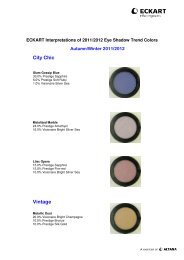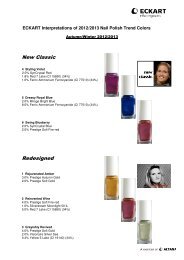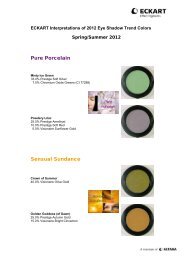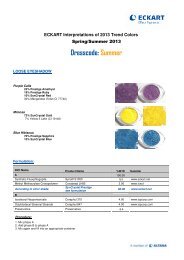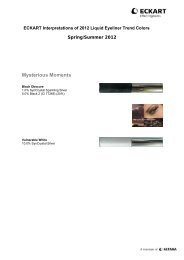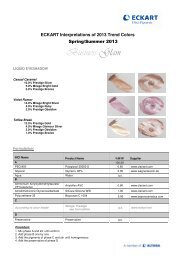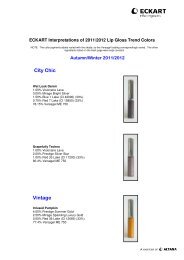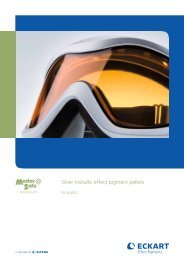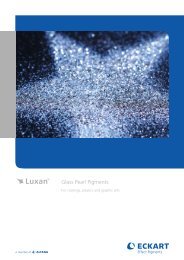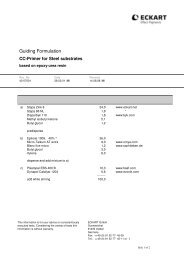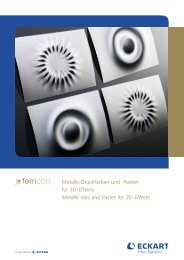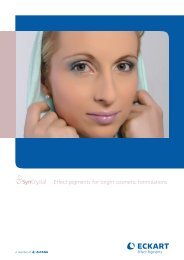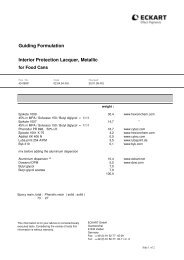Metallic- und Perlglanzeffektpigmente für Pulverlacke ... - Eckart
Metallic- und Perlglanzeffektpigmente für Pulverlacke ... - Eckart
Metallic- und Perlglanzeffektpigmente für Pulverlacke ... - Eckart
Sie wollen auch ein ePaper? Erhöhen Sie die Reichweite Ihrer Titel.
YUMPU macht aus Druck-PDFs automatisch weboptimierte ePaper, die Google liebt.
<strong>Metallic</strong>- <strong>und</strong> <strong>Perlglanzeffektpigmente</strong> <strong>für</strong> <strong>Pulverlacke</strong><br />
<strong>Metallic</strong> and Pearlescent Effect Pigments for Powder Coatings
Inhalt<br />
Contents<br />
3 Einleitung: <strong>Metallic</strong>- <strong>und</strong> <strong>Perlglanzeffektpigmente</strong> <strong>für</strong> <strong>Pulverlacke</strong><br />
2 ECKART<br />
Introduction: metallic and pearlescent effect pigments for powder coatings<br />
5 Einfl uss von Pigmentorientierung <strong>und</strong> Pigmentteilchengröße auf den optischen Effekt (schematisch)<br />
Infl uence of pigment orientation and pigment particle size on the optical effect (schematic)<br />
6 Non-leafi ng Aluminiumpigmente<br />
Non-leafi ng aluminium pigments<br />
7 Leafi ng Aluminiumpigmente<br />
Leafi ng aluminium pigments<br />
8 Non-leafi ng Aluminiumpulver<br />
Non-leafi ng aluminium powders<br />
14 Leafi ng Aluminiumpulver<br />
Leafi ng aluminium powders<br />
16 Non-leafi ng Goldbronzepulver<br />
Non-leafi ng gold bronze powders<br />
STANDART ® PCS · PCR · PCA · PC n. l.<br />
STANDART ® RESIST ·<br />
STANDART ® PC<br />
18 Zinkpigmente <strong>für</strong> Korrosionsschutz-<strong>Pulverlacke</strong> STANDART ® Zinkfl ake AT · GTT<br />
Zinc pigments for anti-corrosive powder coatings STANDART ® Zinc Flake AT · GTT<br />
19 Staubfreie <strong>Metallic</strong>pigment-Granulate <strong>für</strong> die direkte Extrusion in <strong>Pulverlacke</strong><br />
Dust-free metallic pigment pellets for direct extrusion in powder coatings<br />
22 Wetterstabile silberweiße Perlglanzpigmente<br />
Weather resistant silver-white pearlescent pigments<br />
24 Bonding Service<br />
Bonding service<br />
26 Herstellung von <strong>Metallic</strong>- <strong>und</strong> Perlglanzeffekt-<strong>Pulverlacke</strong>n<br />
Manufacture of metallic and pearlescent effect powder coatings<br />
30 Sicherheitsaspekte<br />
Safety recommendations<br />
35 Testmethoden <strong>und</strong> Qualitätskontrolle<br />
Testing methods and quality control<br />
PowderSafe ® · PowderSafe ® n. l.<br />
PHOENIX ® XT
<strong>Metallic</strong>- <strong>und</strong> <strong>Perlglanzeffektpigmente</strong> <strong>für</strong> <strong>Pulverlacke</strong><br />
<strong>Metallic</strong> and pearlescent effect pigments for powder coatings<br />
Kreative Oberfl ächenbeschichtung mit <strong>Metallic</strong>- <strong>und</strong> Perl-<br />
glanzeffekt-<strong>Pulverlacke</strong>n<br />
Die Schonung der Umwelt <strong>und</strong> der natürlichen Ressourcen gehören<br />
zu den großen Herausforderungen unserer Zeit. Ein wichtiges Bei-<br />
spiel <strong>für</strong> die erfolgreiche Umsetzung dieses Anliegens ist die Tech-<br />
nologie der Pulverlackbeschichtung. <strong>Pulverlacke</strong> zeichnen sich im<br />
Wesentlichen dadurch aus, dass sie keinerlei Lösemittel enthalten.<br />
Sie besitzen damit gegenüber anderen Lacksystemen einen ent-<br />
scheidenden Umweltvorteil. Sie lassen sich umweltverträglich<br />
ohne schädliche Lösemittel emissionen applizieren <strong>und</strong> zeigen dar-<br />
über hinaus eine exzellente Material ausnutzung mit einem Auf-<br />
tragswirkungsgrad von bis zu über 98%.<br />
Pulverbeschichtungen besitzen eine hervorragende Ober fl ächen-<br />
qualität <strong>und</strong> sind im Vergleich zu anderen Beschichtungs-<br />
technologien kostengünstiger <strong>und</strong> effi zienter.<br />
Eine Vielzahl von Produkten des täglichen Lebens ist pulver-<br />
beschichtet. Beispiele sind:<br />
· Autozubehörteile <strong>und</strong> Fahrräder,<br />
· Fassadenverkleidungen <strong>und</strong> Fensterrahmen in der Architektur<br />
· Stahlmöbel, Regalsysteme, Heizkörper <strong>und</strong> Leuchten im Innen-<br />
architekturbereich<br />
· Haushaltsgeräte wie Kühlschränke, Herde <strong>und</strong> Waschmaschinen<br />
· etc.<br />
Neben dem Trend zu umweltfre<strong>und</strong>lichen Lacksystemen ist in der<br />
Beschichtungstechnologie ein wachsender Bedarf nach kreativer<br />
Oberfl ächengestaltung mit hohen ästhetischen Ansprüchen zu<br />
beobachten.<br />
Creative surfaces with metallic and pearlescent effect<br />
powder coatings<br />
In today’s world which is focussing more and more on coatings<br />
that meet the ecological need of reducing the solvent amount in<br />
paints, powder coatings are exhibiting the excellent feature of<br />
being 100% solvent-free.<br />
They can easily be applied in an environmentally friendly manner<br />
without producing waste gases or paint sludge. This technology is<br />
also very effi cient since over 98% of the powder coating actually<br />
becomes applied to the substrate.<br />
Powder coatings exhibit excellent surface quality. They are more<br />
cost effi cient and have higher manufacturing productivity in<br />
comparison with other coating technologies.<br />
A wide range of products are powder coated.<br />
Some examples are:<br />
· automotive parts and bicycles<br />
· façade elements and window frames in architecture<br />
· metal furniture, shelving units, lamps and radiators<br />
used for interior design<br />
· household appliances such as refrigerators, stoves<br />
and washing machines<br />
· etc.<br />
Together with the need for more environmentally friendly<br />
paint systems a trend towards highly aesthetic coatings exists,<br />
especially concerning colour and effect.
<strong>Metallic</strong>- <strong>und</strong> <strong>Perlglanzeffektpigmente</strong> <strong>für</strong> <strong>Pulverlacke</strong><br />
<strong>Metallic</strong> and pearlescent effect pigments for powder coatings<br />
Um beiden Anliegen gleichzeitig gerecht zu werden – dem Trend<br />
zu umweltfre<strong>und</strong>lichen Beschichtungsmethoden einerseits <strong>und</strong><br />
dem wachsenden Bedürfnis an ästhetischer <strong>und</strong> hochwertiger<br />
Oberflächenbeschichtung andererseits – wurden <strong>Metallic</strong>- <strong>und</strong><br />
<strong>Perlglanzeffektpigmente</strong> mit maßgeschneiderten Eigenschaften<br />
<strong>für</strong> die Pulverlackierung entwickelt.<br />
<strong>Metallic</strong>- <strong>und</strong> <strong>Perlglanzeffektpigmente</strong> zeichnen sich im Wesentlichen<br />
durch ihre plättchenförmige Struktur aus <strong>und</strong> bestehen<br />
im Falle der <strong>Metallic</strong>pigmente aus metallischen Elementen bzw.<br />
Legierungen (z. B. Aluminium, Kupfer, Messing (Goldbronze)<br />
oder Zink) <strong>und</strong> im Falle der Perlglanzpigmente aus natürlichem<br />
Glimmer, der mit Metalloxiden hoher optischer Dichte (z. B. TiO2)<br />
beschichtet ist.<br />
Prinzipiell bieten <strong>Metallic</strong>- <strong>und</strong> Perlglanzpigmente pulverlackbeschichteten<br />
Oberflächen folgende Vorteile:<br />
· metallisches oder perlglänzendes Aussehen<br />
· polychromatische Farbgestaltung<br />
· funktioneller Schutz<br />
Die Effektbildung bei <strong>Metallic</strong>- <strong>und</strong> Perlglanzeffekt-<strong>Pulverlacke</strong>n<br />
wird im Wesentlichen durch zwei Pigmenteigenschaften<br />
bestimmt:<br />
· Teilchengröße<br />
· Pigmentorientierung (leafing oder non-leafing Verhalten)<br />
Gemäß ihrem unterschiedlichen Orientierungsverhalten werden<br />
plättchenförmige Pigmente in zwei Klassen eingeteilt (Abb. 1):<br />
· leafing Pigmente, die sich bevorzugt planparallel an der oberen<br />
Grenzfläche des Pulverlackfilms orientieren<br />
· non-leafing Pigmente, die sich gleichmäßig im Pulverlackfilm<br />
verteilen<br />
Non-leafing <strong>Metallic</strong>- <strong>und</strong> Perlglanzpigmente besitzen in der industriellen<br />
Pulverlackanwendung eine weitaus größere Bedeutung als<br />
leafing Pigmente. So spielen Pigmente mit leafing-Eigenschaften<br />
bei Goldbronze-, Zink- <strong>und</strong> Perlglanzpigmenten überhaupt keine<br />
Rolle. Lediglich bei Aluminiumpigmenten haben Pigmente mit leafing-Verhalten<br />
eine gewisse Bedeutung.<br />
ECKART<br />
In order to satisfy both demands, the need for environmental<br />
friendliness and highly aesthetic appearance of coatings, metallic<br />
and pearlescent effect pigments – modified and tailor-made<br />
for powder coatings – offer the right option to achieve surface<br />
coatings of high-quality. Due to their physical properties in respect<br />
of reflection and interaction with incident light and depending on<br />
their particle size they offer a wide range of colouristic possibilities<br />
creating effects from crystalline metallic sparkling to silky pearl<br />
appearance.<br />
Effect pigments are flake-shaped metallic particles composed of<br />
aluminium (silver bronze), copper or brass (gold bronze), or zinc<br />
(zinc flakes in contrast to zinc dust) or consist of inorganic mica as<br />
a platelet carrier which is coated with metal oxide (e. g. TiO2).<br />
In principle metallic and pearlescent effect pigments provide the<br />
following benefits to powder coated surfaces:<br />
· metallic or pearlescent appearance<br />
· polychromatic colour design<br />
· functional protection<br />
The formation of the effect of metallic and pearlescent effect<br />
powder coatings is mainly determined by the following two<br />
properties of the platelet effect pigments:<br />
· particle size<br />
· orientation of the pigments (leafing or non-leafing behaviour)<br />
According to their orientation properties, the platelet effect<br />
pigments are divided into two pigment categories (Fig.1):<br />
· leafing pigments, which show a distinct tendency for parallel<br />
alignment at the surface of a powder coating film<br />
· non-leafing pigments, which are evenly distributed in the matrix<br />
of a powder coating film<br />
For both metallic pigments and pearlescent effect pigments,<br />
the non-leafing category occupies the dominant role in industrial<br />
powder coating. The leafing pigment category is only for aluminium<br />
pigments of commercial importance and plays no role for other<br />
types of effect pigments like gold bronze pigments, zinc flakes or<br />
pearlescent effect pigments.
Einfluss von Pigmentorientierung <strong>und</strong> Pigmentteilchengröße<br />
auf den optischen Effekt (schematisch)<br />
Influence of pigment orientation and pigment particle size<br />
on the optical effect (schematic)<br />
Einfluss von Pigmentorientierung <strong>und</strong> Pigmentteilchengröße auf den optischen Effekt (schematisch)<br />
Influence of pigment orientation and pigment particle size on the optical effect (schematic)<br />
Abb. 1/Fig. 1<br />
Pigment-Type/<br />
Type of Pigment<br />
Pigment-Orientierung/<br />
Pigment Orientation<br />
Pigmentgröße/<br />
Pigment Size<br />
Effekt/<br />
Effect<br />
Aluminiumpigmente:<br />
Lackfilm/Paint film<br />
Substrat/Substrate<br />
Feine Pigmente/<br />
Fine Pigments<br />
Seidenglänzend/<br />
Silky Gloss<br />
Non-leafing Pigmente/<br />
Non-leafing Pigments<br />
Die wichtigste Klasse plättchenförmiger Effektpigmente<br />
Grobe Pigmente/<br />
Coarse Pigments<br />
Kristallin glitzernd/<br />
Crystalline Sparkle<br />
Aluminiumpigmente spielen von allen plättchenförmigen Pigmen-<br />
ten die bei weitem wichtigste Rolle <strong>für</strong> die industrielle Anwendung.<br />
Innerhalb dieser Pigmentklasse wiederum machen die non-leafing<br />
Aluminiumpigmente mit mehr als 80% den größten Anteil aus.<br />
Die Palette der optischen Effekte, die sich mit non-leafing<br />
Aluminiumpigmenten darstellen lassen, ist sehr breit. Sie reicht<br />
vom kristallinen Glitzereffekt, der sich bei Verwendung grobteiliger<br />
Aluminiumpigmente ergibt, bis zu subtiler Seidenglanzanmut, die<br />
sich durch feinteilige Aluminiumpigmente darstellen lässt (siehe<br />
Abb. 2).<br />
Non-leafing Aluminiumpigmente zeigen gute Benetzungseigenschaften<br />
<strong>und</strong> verteilen sich gleichmäßig im Lackfilm – im Gegensatz<br />
zu leafing Aluminiumpigmenten, die sich bevorzugt an der<br />
oberen Grenzfläche des Pulverlackfilms orientieren (siehe Abb. 1).<br />
Lackfilm/Paint film<br />
Substrat/Substrate<br />
Feine Pigmente/<br />
Fine Pigments<br />
Chromähnlich/<br />
Chrome-like<br />
Leafing Pigmente/<br />
Leafing Pigments<br />
Grobe Pigmente/<br />
Coarse Pigments<br />
Hellbrillant/<br />
Bright Brilliant<br />
Aluminium pigments:<br />
The most important class of platelet effect pigments<br />
Aluminium pigments are by far the most popular class of platelet<br />
effect pigments for industrial application. The non-leafing pigment<br />
category makes up the largest share of this class of aluminium<br />
pigments with more than 80%.<br />
Non-leafing aluminium pigments offer the possibility to create an<br />
extensive variety of optical effects ranging from crystalline sparkle<br />
with the coarser aluminium pigments, to silky gloss, as seen with<br />
finer pigments (see Fig. 2).<br />
Non-leafing aluminium pigments display good pigment wetting<br />
properties and are evenly distributed in the powder coating film –<br />
in contrast to leafing aluminium pigments which are predominantly<br />
orientated towards the upper surface of the powder coating film<br />
(see Fig. 1).<br />
ECKART
Non-leafing Aluminiumpigmente<br />
Non-leafing aluminium pigments<br />
Die gute Einbindung der non-leafing Pigmente in die Matrix<br />
des Pulverlackfilms leistet einen zusätzlichen Beitrag zum Schutz<br />
der Aluminiumpigmente vor mechanischen <strong>und</strong> chemischen Ein-<br />
flüssen.<br />
Pulverlackbeschichtungen, die non-leafing Aluminiumpigmente<br />
enthalten, zeigen bei mechanischer Belastung deutlich weniger<br />
Metallabrieb <strong>und</strong> weisen eine deutlich höhere Beständigkeit<br />
gegenüber korrosiven Chemikalien aus als Pulverlackbeschich-<br />
tungen, die leafing Aluminiumpigmente enthalten.<br />
Je nach Anforderung an die Beständigkeitseigenschaften stehen<br />
drei verschiedene Pigmentkategorien an non-leafing Aluminium-<br />
pigmenten zur Verfügung:<br />
· High-Performance-Pigmentkategorie: PCS<br />
· Standard-Pigmentkategorie: PCR <strong>und</strong> PCA<br />
· Economy-Pigmentkategorie: PC n.l.<br />
Die drei verschiedenen Pigmentkategorien decken jeweils ein<br />
umfassendes Teilchengrößenspektrum ab, mit denen sich sämtliche<br />
optische Effekte von kristallin glitzernd bis seidenmatt problemlos<br />
darstellen lassen (siehe Abb. 2).<br />
Effekt/Performance-Diagramm <strong>für</strong> non-leafing Aluminiumpigmente<br />
Effect/Performance diagram for non-leafing aluminium pigments<br />
Abb. 1/Fig. 1<br />
ECKART<br />
“High-Performance“ PCS 1000<br />
PCS 1500<br />
PCS 2000<br />
“Standard“<br />
“Economy“<br />
Performance Category<br />
„Performance“<br />
PCR 901<br />
PC n.l. 10<br />
Seiden-glänzend/<br />
Silky gloss<br />
PCR 801 /<br />
PCA 9155 /<br />
PC n.l. 15<br />
The non-leafing aluminium pigments are well embedded into<br />
the matrix of the powder coating film which gives an additional<br />
barrier effect providing further protection for the aluminium<br />
pigments against mechanical and chemical influences.<br />
<strong>Metallic</strong> powder coating finishes containing non-leafing aluminium<br />
pigments perform significantly better <strong>und</strong>er mechanical strain,<br />
with less abrasion of the metallic pigments and noticeably higher<br />
chemical resistance against corrosive chemicals compared to<br />
powder coating finishes based on leafing aluminium pigments.<br />
There are three different pigment categories of non-leafing<br />
aluminium pigments available to meet different requirements:<br />
· High-performance pigment category: PCS<br />
· Standard pigment category: PCR and PCA<br />
· Economy pigment category: PC n.l.<br />
Each of the three pigment categories includes pigment grades<br />
of different particle sizes, providing a variety of optical effects,<br />
ranging from crystalline sparkle to silky gloss (see Fig. 2).<br />
PCR 501 /<br />
PCA 501<br />
PC n.l. 30<br />
PCS 3500<br />
PCR 214 /<br />
PCA 214<br />
PC n.l. 40<br />
PCS 5000<br />
PCR 212 /<br />
PCA 212<br />
PC n.l. 50<br />
Kristallin glitzernd/<br />
Crystalline sparkling<br />
Optischer Effekt/<br />
Optical Effect
Leafing Aluminiumpigmente<br />
Leafing aluminium pigments<br />
Leafing Aluminiumpigmente zeigen – im Gegensatz zu non-leafing<br />
Aluminiumpigmenten – eine ausgeprägte Tendenz, sich planparallel<br />
an der oberen Grenzfläche des Pulverlackfilms auszurichten (Siehe<br />
Abb. 1 auf Seite 5).<br />
Während des Einbrennprozesses können sich hierbei feinteilige<br />
leafing Pigmente leichter <strong>und</strong> besser planparallel an der Oberfläche<br />
der hochviskosen Pulverlackschmelze orientieren als grobteilige<br />
Pigmentpartikel.<br />
Für die Pulverlack-Applikation gilt deshalb folgende Besonderheit:<br />
Je feiner die leafing Pigmente, desto ausgeprägter der erzielbare<br />
Chromeffekt. Daher lassen sich mit besonders feinen leafing Aluminiumpigmenten<br />
besonders brillante Effekte mit hohem Lichtreflexionsvermögen<br />
<strong>und</strong> nahezu chromartiger Optik erzielen.<br />
Aufgr<strong>und</strong> ihrer oberflächennahen Orientierung sind leafing<br />
Aluminiumpigmente weniger stark in die schützende Matrix des<br />
Pulverlackfilms eingeb<strong>und</strong>en <strong>und</strong> daher weniger vor mechanischen<br />
<strong>und</strong> chemischen Einflüssen von außen geschützt als<br />
non-leafing Aluminiumpigmente.<br />
Es ist deshalb notwendig, <strong>Metallic</strong>pulverlacke, die leafing<br />
Aluminiumpigmente enthalten, mit einem geeigneten Klarlack<br />
überzulackieren, um unerwünschten Pigmentabrieb bzw. unerwünschte<br />
Korrosionserscheinungen der <strong>Metallic</strong>pulverlackierung<br />
zu verhindern.<br />
In contrast to non-leafing aluminium pigments, leafing aluminium<br />
pigments exhibit a distinct tendency to float to the surface of the<br />
coating and to align parallel to the surface of the powder coating<br />
film (see Fig. 1 on page 5).<br />
Compared with coarse aluminium pigment particles, fine leafing<br />
aluminium pigments can move more easily towards the surface<br />
of the highly viscous melt of the powder coating film during the<br />
high-temperature curing process – resulting in more distinctive<br />
orientation and parallel alignment to the surface of the powder<br />
coating film.<br />
For powder coatings therefore the special rule applies: the<br />
finer the leafing pigments, the more defined the chrome effect.<br />
Especially fine leafing aluminium pigments create powder coatings<br />
with particularly brilliant effects with extraordinary reflecting<br />
power and chrome-like optical appearance.<br />
As a result of their distinct orientation close to the surface of the<br />
coating film, the leafing aluminium pigments are not completely<br />
embedded in the protective matrix of the powder coating and are<br />
therefore less well protected from mechanical or chemical<br />
influences than non-leafing aluminium pigments.<br />
Therefore it is necessary to overcoat metallic powder coatings with<br />
a protective clear coat in order to protect the leafing metallic<br />
powder coating finish from unwanted corrosion processes and<br />
pigment abrasion.<br />
ECKART
Non-leafing Aluminiumpulver<br />
Non-leafing aluminium powders<br />
STANDART ® PCS<br />
PCS ist eine neue Produktgeneration von Hochleistungs-Aluminium-<br />
pigmenten <strong>für</strong> die Pulverlackanwendung.<br />
Das Besondere an PCS-Pigmenten ist ihre vollständige <strong>und</strong> äußerst<br />
stabile Oberflächenbeschichtung, bei der Pigmente aus hoch-<br />
reinem Aluminium in einem speziellen Sol-Gel-Verfahren in eine<br />
kompakte Siliziumdioxidmatrix eingekapselt werden (PCS = Powder<br />
Coating Sol-Gel-Verfahren).<br />
Der wichtigste Vorteil von PCS-Pigmenten ist ihre außergewöhnlich<br />
gute Chemikalienbeständigkeit. Daher kommen PCS-Pigmente<br />
vor allem dort zum Einsatz, wo höhere Anforderungen an die<br />
Chemikalienbeständigkeit der Pulverlackbeschichtung gestellt<br />
werden <strong>und</strong> die Beständigkeitseigenschaften der Typen PCR <strong>und</strong><br />
PCA nicht ausreichen.<br />
Die entscheidenden Vorteile von PCS-Pigmenten sind:<br />
· hervorragende Chemikalienbeständigkeit<br />
· gute Abriebbeständigkeit in einschichtigen Pulverlack-<br />
Applikationen<br />
· gute Pigmentbenetzung<br />
· ausgeprägte non-leafing Eigenschaften<br />
· gute Scherstabilität – dadurch besonders geeignet<br />
<strong>für</strong> die Verarbeitung im Bondingverfahren<br />
· hohe Farbstärke<br />
· gute elektrische Aufladbarkeit<br />
· problemlose Verarbeitung in der Corona- <strong>und</strong> Tribo-Applikation<br />
Die typische Pigmentierungshöhe von PCS-Aluminium-Pigmenten<br />
beträgt 0,5–5,0%.<br />
Das PCS-Pigmentprogramm umfasst fünf Pigmenttypen, mit denen<br />
sich sämtliche optische Effekte von kristallin glitzernd bis seiden-<br />
matt problemlos darstellen lassen.<br />
ECKART<br />
PCS is a new product generation of high-performance aluminium<br />
pigments for powder coatings.<br />
These pigment grades are completely coated with a very stable<br />
and homogeneous protective layer. Pigments made of high-purity<br />
aluminium are encapsulated in a compact silicon dioxide matrix in<br />
a special sol-gel process (PCS = powder coating sol-gel process).<br />
The most important feature of PCS pigments is their extra-ordinary<br />
chemical resistance. Therefore PCS pigments are preferably used<br />
where the requirements for chemical resistance of powder coatings<br />
are very high and the resistance properties of the PCR and PCA<br />
series are not sufficient.<br />
The decisive advantages of PCS pigments are:<br />
· excellent chemical resistance<br />
· good rub resistance in single-layer powder coating applications<br />
· good pigment wetting<br />
· distinct non-leafing properties<br />
· good shear stability – therefore very suitable for processing<br />
with the bonding technique<br />
· high colour strength<br />
· good electrical charging<br />
· easy processing with Corona and Tribo techniques<br />
The typical pigment level of PCS aluminium pigments varies<br />
between 0.5% and 5.0%.<br />
The PCS pigment range includes five pigment grades which provide<br />
the formulation of an extensive variety of optical effects, from<br />
crystalline sparkling to silky gloss.
STANDART ® PCS<br />
Mittlere Teilchengröße /<br />
Schüttdichte (typischer Wert) /<br />
Siebanalyse / Nasssiebung mit organischen<br />
Average particle size<br />
Bulk density (typical value)<br />
Lösemitteln als Spülflüssigkeit /<br />
Screen analysis / Wet sieving with organic<br />
ermittelt mit / determined with<br />
Sympatec Helos<br />
solvents as rinsing liquid<br />
nach / acc. to DIN 53196<br />
Non-leafing Aluminiumpulver<br />
Non-leafing aluminium powders<br />
STANDART ® PCR<br />
Die Aluminiumpigmente der Typenreihe PCR besitzen eine<br />
anorganische Nachbeschichtung aus Siliziumdioxid. Diese Silikat-<br />
beschichtung garantiert zum einen hervorragende Verarbeitungs-<br />
eigenschaften während der Pulverlack-Applikation, zum anderen<br />
– bedingt durch die Barrierewirkung der SiO2-Schicht – einen<br />
gewissen Schutz gegenüber korrosiven Chemikalien.<br />
Die entscheidenden Vorteile von PCR-Pigmenten sind:<br />
· einzigartige metallische Brillanz<br />
· hohe Farbstärke<br />
· gute elektrische Aufladbarkeit<br />
· problemlose Verarbeitung in der Corona- <strong>und</strong> Tribo-Applikation<br />
· gute Scherstabilität – dadurch besonders geeignet <strong>für</strong> die<br />
Verarbeitung im Bondingverfahren<br />
Die typische Pigmentierungshöhe von PCR-Aluminium-Pigmenten<br />
beträgt 0,5–5,0%.<br />
Das Basis-Produktprogramm der PCR-Typenreihe besteht aus fünf<br />
Pigmenten <strong>und</strong> deckt den gesamten Teilchengrößenbereich von<br />
sehr grob bis sehr fein ab.<br />
10 ECKART<br />
The aluminium pigments of the PCR series are inorganically encap-<br />
sulated with silicon dioxide. On the one hand this silica coating<br />
provides excellent processing properties during powder coating<br />
application, on the other hand – due to the barrier effect of the<br />
SiO2-layer – it guarantees a certain protection against corrosive<br />
chemicals.<br />
The decisive advantages of PCR aluminium pigments are:<br />
· unique metallic brilliance<br />
· high colour strength<br />
· good electrical charging<br />
· easy processing with Corona and Tribo techniques<br />
· good shear stability – therefore very suitable for processing<br />
with the bonding technique<br />
The typical pigment level of PCR aluminium pigments varies<br />
between 0.5% and 5.0%.<br />
The basic product programme of PCR comprises a selection<br />
of five pigment grades ranging from very coarse to very fine.<br />
STANDART ® PCR<br />
Mittlere Teilchengröße /<br />
Schüttdichte (typischer Wert)/<br />
Siebanalyse / Nasssiebung mit organischen<br />
Average particle size<br />
Bulk density (typical value)<br />
Lösemitteln als Spülflüssigkeit /<br />
Screen analysis / Wet sieving with organic<br />
ermittelt mit / determined with<br />
Sympatec Helos<br />
solvents as rinsing liquid<br />
nach / acc. to DIN 53196<br />
STANDART ® PCA<br />
Alternativ zur anorganischen Pigmentbeschichtung der Typenreihe<br />
PCR sind die Pigmente der Typenreihe PCA mit einer organischen<br />
Polymerschicht umhüllt.<br />
In einzelnen Fällen hat sich gezeigt, dass sie gegenüber den Pigmenten<br />
der Typenreihe PCR leichte Vorteile im Hinblick auf ihre Beständigkeitseigenschaften<br />
aufweisen.<br />
Die wesentlichen Vorteile der PCA-Pigmente sind:<br />
· gute Pigmentbenetzung<br />
· ausgeprägte non-leafing Eigenschaften<br />
· gute Abriebbeständigkeit in einschichtigen Pulverlack-<br />
Applikationen<br />
Die typische Pigmentierungshöhe von PCA-Aluminium-Pigmenten<br />
beträgt 0,5–5,0%.<br />
Das Basis-Produktprogramm der PCA-Typenreihe besteht aus vier<br />
Pigmenten <strong>und</strong> deckt den Teilchengrößenbereich von sehr grob bis<br />
fein ab.<br />
As an alternative to the inorganic pigment coating of the PCR<br />
series, the pigments of the PCA series are encapsulated with<br />
organic polymer layers.<br />
In some cases it has been noticed that they offer slight benefits<br />
regarding the resistance properties compared with the PCR<br />
pigment grades.<br />
The substantial advantages of PCA aluminium pigments are:<br />
· good pigment wetting<br />
· distinct non-leafing properties<br />
· good rub resistance in single layer powder coating applications<br />
The typical pigment level of PCA aluminium pigments varies<br />
between 0.5% and 5.0%.<br />
The basic pigment programme of PCA comprises a selection of<br />
four pigment grades ranging from very coarse to fine.<br />
STANDART ® PCA<br />
Mittlere Teilchengröße /<br />
Schüttdichte (typischer Wert) /<br />
Siebanalyse / Nasssiebung mit organischen<br />
Average particle size<br />
Bulk density (typical value)<br />
Lösemitteln als Spülflüssigkeit /<br />
Screen analysis / Wet sieving with organic<br />
ermittelt mit / determined with<br />
Sympatec Helos<br />
solvents as rinsing liquid<br />
nach / acc. to DIN 53196<br />
Non-leafing Aluminiumpulver<br />
Non-leafing aluminium powders<br />
STANDART ® PC n.l.<br />
Die Pigmente der Typenreihe PC n.l. sind non-leafing Aluminium-<br />
pigmentpulver, die speziell <strong>für</strong> die Pulverlackapplikation entwickelt<br />
wurden.<br />
Das Besondere an PC n.l. ist die Oberflächenbehandlung der<br />
einzelnen Pigmente, bei der über ein spezielles Verfahren auf<br />
jedem Aluminiumpigment eine definierte Schicht aus Aluminiumoxid<br />
mit einer Schichtdicke von 20 nm aufgebaut wird (siehe<br />
Abb.3). Diese Oberflächenveredelung aus Aluminiumoxid ist maßgeblich<br />
<strong>für</strong> die hervorragenden elektrischen Aufladungseigenschaften<br />
von PC n.l.-Aluminiumpigmenten verantwortlich.<br />
PC n.l.-Pigmente sind nicht mit einer weiteren Schutzbeschichtung<br />
versehen worden, weshalb die Beständigkeit gegenüber korrosiven<br />
Chemikalien im Allgemeinen etwas geringer als bei anderen<br />
beschichteten non-leafing Aluminiumpigmenten ausfällt (wie beispielsweise<br />
den mit einer zusätzlichen organischen Acrylatschicht<br />
versehenen PCA- oder den mit einer anorganischen Silikatschicht<br />
umhüllten PCR- <strong>und</strong> PCS-Pigmenten).<br />
REM-Aufnahme am Querschliff von PC n.l. 0 mit<br />
deutlich erkennbarer nano-skaliger Pigmentbeschichtung<br />
aus Aluminiumoxid/SEM photo of cross section<br />
of PC n.l. 40 with clearly visible nano-sized layer of<br />
aluminium oxide<br />
Abb. 3/Fig. 3 Vergrößerung: x 10.000/magnification: x 10.000<br />
1 µm<br />
12 ECKART<br />
The PC n.l. pigments are non-leafing aluminium pigment powders<br />
which have been developed especially for powder coating<br />
applications.<br />
The PC n.l. pigments are characterized by a special surface<br />
treatment in which an aluminium oxide layer of defined thickness<br />
(20 nm) is formed on the surface of each of the aluminium pigments<br />
(see Fig. 3). This leads to extraordinary electrical charging properties<br />
of the PC n.l. aluminium pigments resulting in excellent processing<br />
properties during powder coating application.<br />
PC n.l. pigments are not provided with an additional protective<br />
surface layer. Compared with non-leafing aluminium pigments<br />
with additional chemical surface coatings such as PCA pigments<br />
(with an acrylic pigment coating) or PCR and PCS pigments (with<br />
an inorganic silica encapsulation), PC n.l. pigments exhibit therefore<br />
somewhat less performance with respect to corrosive<br />
chemicals.
Ein wesentlicher Vorteil der PC n.l.-Pigmente ist ihr günstiges Preis/<br />
Leistungsverhältnis – bedingt durch die Einsparung der vergleichs-<br />
weise hohen Prozesskosten, wie sie bei der zusätzlichen chemischen<br />
Nachbeschichtung von PCA-, PCR- oder PCS-Pigmenten anfallen.<br />
Die entscheidenden Vorteile von PC n.l.-Pigmenten sind:<br />
· günstiges Preis/Leistungsverhältnis<br />
· sehr gute Verarbeitbarkeit (sowohl in dry-geblendeten<br />
als auch gebondeten Pulverlacksystemen)<br />
· gute elektrische Aufladbarkeit (bei Corona- <strong>und</strong><br />
Tribo-Applikation)<br />
· gute Pigmentbenetzung<br />
· ausgeprägte non-leafing Eigenschaften<br />
· gute Abriebbeständigkeit in einschichtigen Pulverlack-<br />
Applikationen<br />
· gute Scherstabilität – dadurch besonders gut geeignet<br />
<strong>für</strong> die Verarbeitung im Bondingverfahren<br />
Die typische Pigmentierungshöhe von PC n.l.-Aluminiumpigmenten<br />
beträgt 1,0–5,0%.<br />
Das PC n.l.-Pigmentprogramm umfasst fünf Pigmenttypen, mit<br />
denen sich sämtliche optische Effekte von kristallin glitzernd bis<br />
seidenmatt problemlos darstellen lassen.<br />
A very significant advantage of PC n.l. is its attractive price/<br />
performance ratio – a result of saving the additional processing<br />
costs of the expensive process step of chemical pigment<br />
encapsulation as is required for PCA, PCR or PCS pigments.<br />
The decisive advantages of the PC n.l. pigments are:<br />
· good price/performance ratio<br />
· very good processability (in dry-blended as well as in<br />
bonded powder coating systems)<br />
· good electrical charging (with Corona and Tribo techniques)<br />
· good pigment wetting<br />
· distinct non-leafing properties<br />
· good rub resistance in single-layer powder coating applications<br />
· good shear stability – therefore very suitable for processing<br />
with the bonding technique<br />
The typical pigment level of PC n.l. aluminium pigments varies<br />
between 1.0% and 5.0%.<br />
The PC n.l. pigment range includes five pigment grades providing<br />
a variety of optical effects, ranging from crystalline sparkling to<br />
silky gloss.<br />
STANDART ® PC n. l. Mittlere Teilchengröße /<br />
Schüttdichte (typischer Wert) /<br />
Siebanalyse / Nasssiebung mit organischen<br />
Average particle size<br />
Bulk density (typical value)<br />
Lösemitteln als Spülflüssigkeit /<br />
Screen analysis / Wet sieving with organic<br />
ermittelt mit / determined with<br />
Sympatec Helos<br />
solvents as rinsing liquid<br />
nach / acc. to DIN 53196<br />
Leafing Aluminiumpulver<br />
Leafing aluminium powders<br />
STANDART ® PC<br />
Die Pigmente der Typenreihe PC sind hochbrillante leafing Alumi-<br />
niumpigmentpulver, die speziell <strong>für</strong> die Pulverlack-Applikation ent-<br />
wickelt wurden.<br />
Die ausgeprägte Orientierung der PC leafing Aluminiumpigmente<br />
an der Pulverlackoberfläche sowie die planparallele Pigmentausrichtung<br />
ermöglichen außergewöhnlich brillante, chromeffektähnliche<br />
Beschichtungen. Dabei gilt: Je feiner die PC leafing<br />
Pigmente sind, desto ausgeprägter ist der Chromeffekt.<br />
Zu den wesentlichen Vorteilen der Pigmente der PC leafing<br />
Pigmentserie zählen:<br />
· hervorragende Dispergierbarkeit<br />
· hohe Farbstärke (besonders auch in dry-geblendeten Pulverlacksystemen)<br />
· sehr gute Pigmentergiebigkeit (vollständiges Deckvermögen bei<br />
Pigmentierungshöhen von 1–2%)<br />
· sehr gute Verarbeitbarkeit (sowohl in dry-geblendeten als auch<br />
gebondeten Pulverlacksystemen)<br />
· gute elektrische Aufladbarkeit<br />
· problemlose Verarbeitung in der Corona- <strong>und</strong> Tribo-Applikation<br />
Die typische Pigmentierungshöhe von PC leafing Aluminiumpigmenten<br />
beträgt 0,4–2,0%.<br />
Für wischfeste oder chemikalienbeständige bzw. wetterfeste<br />
Beschichtungen empfiehlt sich die Überlackierung mit einem<br />
geeigneten Klarlack.<br />
1 ECKART<br />
The pigments of the PC series are highly brilliant leafing aluminium<br />
pigment powders which are especially designed for powder<br />
coating applications.<br />
The distinctive orientation and parallel alignment of the PC leafing<br />
aluminium pigments to the surface of the powder coating film<br />
yield extraordinarily brilliant, chrome-like coating effects.<br />
In this context the rule stating that the finer the PC leafing<br />
pigments, the more defined the chrome effect applies.<br />
The decisive advantages of the PC leafing pigment grades are:<br />
· excellent dispersibility<br />
· high colour strength (particularly also in dry-blended powder<br />
coating systems)<br />
· outstanding yield rate (complete hiding power at a pigment<br />
level of 1 % to 2%)<br />
· very good processability (in dry-blended as well as in bonded<br />
powder coating systems)<br />
· good electrical charging<br />
· easy processing with Corona and Tribo techniques<br />
The typical pigment level of PC leafing aluminium pigments varies<br />
between 0.4% and 2.0%.<br />
For abrasion resistant coatings and whenever demands are placed<br />
on chemical resistance or weather stability an adequate protective<br />
clear coat is recommended.
STANDART ® PC<br />
Mittlere Teilchengröße /<br />
Schüttdichte (typischer Wert) /<br />
Siebanalyse / Nasssiebung mit organischen<br />
Average particle size<br />
Bulk density (typical value)<br />
Lösemitteln als Spülflüssigkeit /<br />
Screen analysis / Wet sieving with organic<br />
ermittelt mit / determined with<br />
Sympatec Helos<br />
solvents as rinsing liquid<br />
nach / acc. to DIN 53196<br />
Non-leafing Goldbronzepulver<br />
Non-leafing gold bronze powders<br />
STANDART ® Resist · DOROLAN ®<br />
Die Goldbronzepigmente der Typenreihen Resist <strong>und</strong> DOROLAN ®<br />
bestehen aus einem metallischen Kern (Kupfer bzw. Kupfer/Zink-<br />
legierungen), der gleichmäßig von einer dichten Silikatschicht<br />
umschlossen ist. Diese Schutzschicht bewirkt eine erhöhte Hitzebeständigkeit<br />
der Typenreihen Resist <strong>und</strong> DOROLAN ® gegenüber<br />
unbeschichteten Goldbronzepigmenten <strong>und</strong> verhindert unerwünschte<br />
Farbtonveränderungen beim Einbrennen des Pulverlacks.<br />
Verglichen mit den Resist-Pigmenten weist die Typenreihe<br />
DOROLAN ® eine noch ausgeprägtere Brillanz verb<strong>und</strong>en mit einer<br />
höheren Farbstärke auf.<br />
Die Produkte Resist <strong>und</strong> DOROLAN ® finden vor allem im Innenbereich<br />
Anwendung <strong>und</strong> überall dort, wo die Beständigkeitseigenschaften<br />
der Pulverlackbeschichtung eine untergeordnete<br />
Rolle spielen. Für Anwendungen im Außenbereich hingegen <strong>und</strong><br />
bei hohen Anforderungen an die chemische Beständigkeit ist die<br />
Überlackierung mit einem schützenden Klarlack erforderlich.<br />
Die wesentlichen Vorteile der Resist- <strong>und</strong> DOROLAN ® -Goldbronzepigmente<br />
sind:<br />
· einzigartige metallische Brillanz<br />
· hervorragende Lichtbeständigkeit<br />
· gutes Deckvermögen <strong>und</strong> hohe Farbstärke<br />
· exzellente Hitzebeständigkeit (bis zu 200 °C)<br />
· gute Farbtonstabilität beim Einbrennen des Pulverlacks<br />
1 ECKART<br />
The gold bronze pigments of the Resist and DOROLAN ® series consist<br />
of a metallic core (copper or copper/zinc alloys) which is encapsulated<br />
with homogeneous and compact silicate coatings. This<br />
protective layer increases the heat resistance of the Resist and<br />
DOROLAN ® grades compared with uncoated gold bronze pigments<br />
and effectively inhibits unwanted colour shifts during the<br />
high- temperature powder coating curing process.<br />
Compared to the Resist grades, the DOROLAN ® series provides an<br />
even more distinct brilliance in combination with higher colour<br />
strength.<br />
The products Resist and DOROLAN ® are preferably used for interior<br />
application and where the resistance properties play a less decisive<br />
role. For exterior application and whenever demands are placed on<br />
chemical resistance an over coating with an adequate protective<br />
clear coat is mandatory.<br />
The substantial advantages of the Resist and DOROLAN ® gold<br />
bronze pigment series are:<br />
· unique metallic brilliance<br />
· outstanding light fastness<br />
· good hiding power and high colour strength<br />
· excellent heat resistance (up to 200 °C)<br />
· good colour stability during the powder coating curing process
Die typische Pigmentierungshöhe von Resist- <strong>und</strong> DOROLAN ® -<br />
Goldbronzepigmenten beträgt 1.0 – 10.0%.<br />
Neben ihrer einzigartigen coloristischen Vielfalt umfassen die<br />
Typenreihen Resist <strong>und</strong> DOROLAN ® jeweils vier Teilchengrößenbereiche,<br />
mit denen sich sämtliche optische Effekte von glitzernd<br />
bis seidenmatt problemlos darstellen lassen.<br />
DOROLAN ®<br />
1 = Kupfer, 3 = Bleichgold, 6 = Reichbleichgold, 9 = Reichgold, 20 = Englischgrün, 22 = Citron, 26 = Dukatengold, 28 = Feuerrot<br />
1 = copper, 3 = pale gold, 6 = rich pale gold, 9 = rich gold, 20 = English green gold, 22 = lemon, 26 = deep gold, 28 = fire red<br />
The typical pigment level of Resist and DOROLAN ® gold bronze<br />
pigments varies between 1.0% and 10.0%.<br />
In addition to their unique coloristical features the Resist pigments<br />
and the DOROLAN ® pigment series each include four pigment<br />
grades of different particle size distributions providing a variety<br />
of optical effects, ranging from sparkling to silky gloss.<br />
STANDART ® Resist<br />
Mittlere Teilchengröße / Schüttdichte (typischer Siebanalyse / Nasssiebung mit organischen Farbtöne*/<br />
Average particle size Wert) / Bulk density Lösemitteln als Spülflüssigkeit /<br />
Colour shades*<br />
(typical value)<br />
Screen analysis / Wet sieving with organic<br />
ermittelt mit / determined<br />
with Sympatec Helos<br />
solvents as rinsing liquid<br />
nach / acc. to DIN 53196<br />
Zinkpigmente <strong>für</strong> Korrossionsschutz-<strong>Pulverlacke</strong><br />
Zinc pigments for anti-corrosive powder coatings<br />
STANDART ® Zinkflake · STANDART ® Zinc Flake<br />
Zinkflake AT <strong>und</strong> Zinkflake GTT sind plättchenförmige Korrosions-<br />
schutzpigmente aus metallischem Zink, die <strong>für</strong> den Einsatz in<br />
Pulverlackprimern hervorragend geeignet sind.<br />
Sie bieten aufgr<strong>und</strong> ihres metallischen Charakters nicht nur<br />
einen guten kathodischen Korrosionsschutz, sondern bewirken im<br />
Pulverlackfilm dank ihrer lamellaren Form auch einen hervorragenden<br />
Barriereschutz mit deutlich reduzierter Durchlässigkeit<br />
gegenüber korrosiven Substanzen.<br />
Gewöhnlich kommen die plättchenförmigen Zinkpigmente<br />
Zinkflake AT <strong>und</strong> Zinkflake GTT in Kombination mit anderen<br />
Korrosionsschutzpigmenten zum Einsatz.<br />
Besonders bewährt haben sich Mischungen mit anderen plättchenförmigen<br />
Substraten (z. B. Eisenglimmer oder Aluminiumpigmenten)<br />
sowie mit sphärischen anorganischen <strong>und</strong> metallischen Substanzen<br />
wie Eisen-/Zinkphosphaten (-silikaten bzw. -zirkonaten) oder Zinkstaub.<br />
Zur Herstellung zinkpigmenthaltiger Pulverlackprimer werden<br />
Zinkflake AT oder Zinkflake GTT (10–15%) mit den anderen<br />
Korrosionsschutzpigmenten (40–60%) <strong>und</strong> Pulverlackrohstoffen<br />
vermischt, extrudiert, vermahlen <strong>und</strong> gesiebt.<br />
1 ECKART<br />
Zinc Flake AT and Zinc Flake GTT are platelet pigments consisting<br />
of metallic zinc, providing excellent corrosion protection properties<br />
for powder coating primers.<br />
Apart from offering cathodic corrosion protection, they provide –<br />
due to their lamellar structure – an additional barrier effect in the<br />
powder coating film, resulting in a significantly reduced permeability<br />
to corrosive agents.<br />
For formulating powder coating primers the platelet zinc pigments<br />
Zinc Flake AT and Zinc Flake GTT are normally combined with other<br />
anti-corrosive pigments.<br />
Particularly combinations with other platelet substrates (e. g. with<br />
micaceous iron or aluminium pigments) as well as with spherical<br />
inorganic or metallic substances such as iron/zinc phosphates<br />
(silicates or zirconates) or zinc dust have been successfully proved<br />
in practice.<br />
For the production of zinc-based powder coating primers, Zinc<br />
Flake AT or Zinc Flake GTT (10%–15%) are added with the other<br />
anti-corrosive pigments (40%–60%) at the premix stage, followed<br />
by extruding, grinding and sieving.<br />
STANDART ®<br />
Mittlere Teilchengröße /<br />
Schüttdichte (typischer Wert) /<br />
Siebanalyse / Nasssiebung mit organischen<br />
Zinkflake / Zinc flake Average particle size<br />
Bulk density (typical value)<br />
Lösemitteln als Spülflüssigkeit /<br />
Screen analysis / Wet sieving with organic<br />
ermittelt mit / determined with<br />
Sympatec Helos<br />
solvents as rinsing liquid<br />
nach / acc. to DIN 53196<br />
Staubfreie <strong>Metallic</strong>pigment-Granulate <strong>für</strong> die direkte<br />
Extrusion in <strong>Pulverlacke</strong><br />
Dust-free metallic pigment pellets for direct<br />
extrusion in powder coatings<br />
POWDERSAFE ® · POWDERSAFE ® n.l.<br />
POWDERSAFE ® <strong>und</strong> POWDERSAFE ® n.l. sind pelletierte Gold-<br />
bronze- <strong>und</strong> Aluminiumpigment-Präparationen, die speziell zur<br />
direkten Extrusion in <strong>Pulverlacke</strong> entwickelt wurden.<br />
Die Verarbeitung von POWDERSAFE ® <strong>und</strong> POWDERSAFE ® n.l. ist<br />
sehr einfach: POWDERSAFE ® bzw. POWDERSAFE ® n.l. wird mit den<br />
anderen Pulverlackrohstoffen vermischt, extrudiert <strong>und</strong> vermah-<br />
len. Mit POWDERSAFE ® bzw. POWDERSAFE ® n.l. lassen sich Metal-<br />
lic-<strong>Pulverlacke</strong> herstellen, bei denen die zusätzlichen Arbeitschritte<br />
wie das „Dry-Blenden“ oder „Bonden“ mit <strong>Metallic</strong>pigmenten<br />
entfallen.<br />
Je nach Type beträgt der Metallpigmentgehalt der POWDERSAFE ® -<br />
<strong>und</strong> POWDERSAFE ® n.l.-Granulate 80%, 85% oder 90%.<br />
Die wichtigsten Vorteile von POWDERSAFE ® <strong>und</strong><br />
POWDERSAFE ® n.l. sind:<br />
· Staubfreiheit<br />
· einfache <strong>und</strong> sichere Handhabung<br />
· hervorragende Lagerstabilität<br />
· kostengünstige Herstellmethode von <strong>Metallic</strong>-<strong>Pulverlacke</strong>n<br />
· keine Separation der <strong>Metallic</strong>pigmente bei Applikation <strong>und</strong><br />
Pulverrückgewinnung<br />
POWDERSAFE ® and POWDERSAFE ® n.l. are pelletized gold bronze<br />
and aluminium pigment preparations developed for the direct<br />
extrusion in powder coatings.<br />
The processing of POWDERSAFE ® and POWDERSAFE ® n.l. is very<br />
easy and convenient: POWDERSAFE ® resp. POWDERSAFE ® n.l. is<br />
added to the other raw materials at the premix stage, followed by<br />
extruding and grinding. POWDERSAFE ® resp. POWDERSAFE ® n.l.<br />
allows an easy production of metallic powder coatings without<br />
additional processing steps such as dry-blending or bonding.<br />
POWDERSAFE ® and POWDERSAFE ® n.l. are supplied in a soft<br />
granule form with a typical metal content of 80%, 85% or 90%.<br />
The most important advantages of POWDERSAFE ® and<br />
POWDERSAFE ® n.l. are:<br />
· dust-free<br />
· easy and safe handling<br />
· excellent shelf stability<br />
· cost-effective method of producing metallic powder coatings<br />
(no dry-blending or bonding necessary)<br />
· no separation of the metallic pigments during powder coating<br />
application and recovery of the overspray<br />
ECKART 1
Staubfreie <strong>Metallic</strong>pigment-Granulate <strong>für</strong><br />
die direkte Extrusion in <strong>Pulverlacke</strong><br />
dust-free metallic pigment pellets for<br />
direct extrusion in powder coatings<br />
POWDERSAFE ®<br />
Die Einzigartigkeit von POWDERSAFE ® besteht darin, dass auch<br />
nach dem Extrusions- <strong>und</strong> Vermahlungsschritt der metallische<br />
Effekt weitgehend erhalten bleibt.<br />
POWDERSAFE ® kommt bevorzugt bei folgenden Anwendungen<br />
zum Einsatz:<br />
· Antik- <strong>und</strong> Hammerschlageffekte<br />
· <strong>Metallic</strong>-Volltöne<br />
· changierende Effekte mit winkelabhängiger Farbgestaltung<br />
(durch Kombination mit organischen <strong>und</strong> anorganischen<br />
Buntpigmenten)<br />
POWDERSAFE ® besitzt leafing-Verhalten <strong>und</strong> zeigt daher nur<br />
mäßige Beständigkeitseigenschaften in einschichtigen Pulverlack-<br />
Applikationen.<br />
Die typische Pigmentierungshöhe von POWDERSAFE ® liegt bei<br />
2.0–10.0%<br />
POWDERSAFE ®<br />
20 ECKART<br />
Mittlere Teilchengröße /<br />
average particle size<br />
ermittelt mit /<br />
determined with<br />
Cilas 1064<br />
The most unique feature of PowderSafe ® is to keep the metallic<br />
effect, even after the extrusion process and after the milling step.<br />
PowderSafe ® is especially suitable for the production of:<br />
· antique and hammer effect finishes<br />
· full-shade metallic finishes<br />
· iridescent-like effects with angle dependent colour design<br />
(in combination with organic and inorganic colour pigments)<br />
PowderSafe ® exhibits leafing behaviour resulting in moderate<br />
chemical resistance properties in single-layer powder coating<br />
applications.<br />
The typical pigment level of PowderSafe ® varies between 2.0%<br />
and 10.0%.<br />
Metallpigmentgehalt /<br />
Metal pigment content<br />
PE Wachsanteil/<br />
Content of Pe wax<br />
Typ / Type<br />
D50 ca. / approx. µm %<br />
%<br />
%<br />
POWDERSAFE ® 1790-01 Kupfer/Copper 17 90 5 5<br />
POWDERSAFE ® 1785-01 Reichgold/rich Gold 17 85 5 10<br />
POWDERSAFE ® 1785-01 Reichbleichgold/<br />
rich Pale Gold<br />
17 85 5 10<br />
POWDERSAFE ® 1785-01 Bleichgold/Pale Gold 17 85 5 10<br />
POWDERSAFE ® 1080-01 Silber/Silver 21 80 5 15<br />
Anteil an Dispergierhilfsmittel/<br />
Content of dispersing<br />
agent
POWDERSAFE ® n.l.<br />
POWDERSAFE ® n.l. zeigt ausgeprägtes non-leafing-Verhalten.<br />
Als Folge der guten Einbindung der POWDERSAFE ® n.l.-Pigmente<br />
in die Matrix des Pulverlackfilms lassen sich Pulverlackbeschichtungen<br />
mit ausgezeichnetem Abrieb <strong>und</strong> hervorragender<br />
Chemikalienbeständigkeit herstellen.<br />
POWDERSAFE ® n.l. eignet sich weniger zur Herstellung von<br />
<strong>Metallic</strong>-Volltönen, sondern findet vor allem dort Einsatz, wo es<br />
gewünscht wird, „normal“ pigmentierte <strong>Pulverlacke</strong> mit<br />
metallischer Anmut optisch aufzuwerten.<br />
POWDERSAFE ® n.l. zeichnet sich durch folgende Vorteile aus:<br />
· exzellente Chemikalien- <strong>und</strong> Abriebbeständigkeit<br />
· optische Aufwertung von „normalen“ <strong>Pulverlacke</strong>n mit<br />
metallischer Anmut<br />
Die typische Pigmentierungshöhe von POWDERSAFE ® n.l. liegt<br />
bei 1.0–5.0%.<br />
POWDERSAFE ® n. l.<br />
Mittlere Teilchengröße /<br />
average particle size<br />
ermittelt mit /<br />
determined with<br />
Cilas 1064<br />
PowderSafe ® n.l. exhibits pronounced non-leafing behaviour<br />
providing powder coatings with excellent abrasion resistance and<br />
excellent chemical resistance - a result of the good pigment embed-<br />
ding into the matrix of the powder coating film.<br />
PowderSafe ® n.l. is not primarily designed to create full-shade<br />
metallic effects but rather is intended to provide an optical upgrade<br />
by adding a metallic touch to ”normal“ powder coatings<br />
The decisive advantages of PowderSafe ® n.l. are:<br />
· excellent abrasion and chemical resistance<br />
· optical upgrading of ”normal“ powder coatings through<br />
addition of a metallic touch<br />
The typical pigment level of PowderSafe ® n.l. varies between<br />
1.0% and 5.0%.<br />
Metallpigmentgehalt /<br />
Metal pigment content<br />
PE Wachsanteil/<br />
Content of Pe wax<br />
Typ / Type<br />
D50 ca./approx. µm %<br />
%<br />
%<br />
PowderSafe ® n.l. 5080-01 Silber/Silver 56 80 5 15<br />
PowderSafe ® n.l. 3580-01 Silber/Silver 38 80 5 15<br />
PowderSafe ® n.l. 2080-01 Silber/Silver 23 80 5 15<br />
PowderSafe ® n.l. 1580-01 Silber/Silver 17 80 5 15<br />
Anteil an Dispergierhilfsmittel/<br />
Content of dispersing<br />
agent<br />
ECKART 21
Wetterstabile silberweiße Perlglanzpigmente<br />
Weather resistant silver-white pearlescent pigments<br />
PHOENIX ® XT<br />
PHOENIX ® XT Perlglanzpigmente sind wetterstabile Effektpigmente,<br />
die speziell <strong>für</strong> den Einsatz in <strong>Pulverlacke</strong>n entwickelt wurden.<br />
PHOENIX ® XT Perlglanzpigmente bestehen aus dünnen Plättchen<br />
des natürlichen Minerals Glimmer, umhüllt mit einer dünnen<br />
Schicht aus Metalloxiden, z. B. Titandioxid (TiO2).<br />
Das Besondere an den PHOENIX ® XT Perlglanzpigmenten ist ihre<br />
außergewöhnliche Wetterbeständigkeit, die durch eine speziell<br />
auf das jeweilige Pigment abgestimmte Stabilisierung erzielt wird.<br />
Im XT-Stabilisierungsverfahren werden die silberweißen Perlglanz-<br />
pigmente mit einer zusätzlichen stabilisierenden Metalloxidschicht<br />
überzogen. Das XT-Verfahren garantiert, dass bei einem geringen<br />
Gehalt von Cr(III) (< 0,5%) ein Maximum an Wetterstabilität<br />
gewährleistet werden kann.<br />
Das Pigmentprogramm der silberweißen PHOENIX ® XT Perlglanz-<br />
pigmente umfasst fünf Pigmenttypen, mit denen sich sämtliche<br />
optische Effekte von seidenmatt bis kristallin glitzernd problemlos<br />
darstellen lassen.<br />
Die entscheidenden Vorteile von PHOENIX ® XT Perlglanzpigmenten<br />
sind:<br />
· hervorragende Wetterbeständigkeit<br />
· hohe Farbstärke<br />
· gleichbleibend hohe Qualität der Pulverlackbeschichtung durch<br />
exakt definierte Korngrößenverteilung<br />
· gute elektrische Aufladbarkeit<br />
· problemlose Verarbeitung in der Corona <strong>und</strong> Tribo-Applikation<br />
· gute Abriebbeständigkeit in einschichtigen Pulverlack-<br />
Applikationen<br />
· gute Pigmentbenetzung<br />
· ausgeprägte non-leafing Eigenschaften<br />
· gute Scherstabilität – dadurch besonders geeignet <strong>für</strong> die Ver-<br />
arbeitung im Bondingverfahren<br />
Die typische Pigmentierungshöhe von PHOENIX ® XT Perlglanz-<br />
pigmenten beträgt 1,0–5,0%.<br />
22 ECKART<br />
PHOENIX ® XT pearlescent pigments are weather resistant effect<br />
pigments especially designed for use in powder coating applica-<br />
tion.<br />
PHOENIX ® XT pearlescent pigments consist of thin platelets of the<br />
natural mineral mica coated with a thin layer of metal oxide, e. g.<br />
titanium dioxide (TiO2).<br />
The special feature of PHOENIX ® XT pearlescent pigments is their<br />
extraordinary weather resistance which is achieved by means of a<br />
stabilisation especially adjusted to each pigment. During the XT<br />
stabilisation process the silver-white pearlescent pigments are<br />
coated with an additionally stabilising metal oxide layer. The XT<br />
process ensures that maximum weather resistance is guaranteed<br />
with a low Cr(III) content (< 0.5%).<br />
The PHOENIX ® XT pigment range includes five pigment grades<br />
which provide an easy formulation of all kinds of optical effects,<br />
from silky gloss to crystalline sparkle.<br />
The decisive advantages of PHOENIX ® XT pearlescent pigments are:<br />
· excellent weather resistance<br />
· high colour strength<br />
· consistent high quality of powder coatings due to<br />
exactly defined particle size distribution<br />
· good electrical charging<br />
· easy processing with Corona and Tribo techniques<br />
· good abrasion resistance in single-layer powder coatings<br />
· good pigment wetting<br />
· distinct non-leafing properties<br />
· good shear stability – therefore very suitable for processing<br />
with the bonding technique<br />
The typical pigment level of PHOENIX ® XT pearlescent<br />
pigments varies between 1.0% and 5.0%.
PHOENIX ® XT Mittlere Teilchengröße / Farbe /<br />
Glanz /<br />
Gehalt /<br />
Average particle size<br />
ermittelt mit /<br />
determined with<br />
Malvern<br />
Colour<br />
Brilliance<br />
Content<br />
%<br />
Glimmer / TiO2 SnO2 Cr(III)<br />
Typ / Type<br />
D50 µm<br />
Mica<br />
PHOENIX ® XT 5001 52 – 65 Silberweiß / Silver-white kristallin glitzernd / crystalline sparkling 74 – 85 15 – 25 < 1 < 0,5<br />
PHOENIX ® XT 4001 29 – 41 Silberweiß / Silver-white glitzernd / sparkling 68 – 77 23 – 31 < 1 < 0,5<br />
PHOENIX ® XT 1001 18 – 22 Silberweiß / Silver-white brillant / brilliant 66 – 74 26 – 32 < 1 < 0,5<br />
PHOENIX ® XT 2001 8 – 12 Silberweiß / Silver-white fein brillant / fine brilliant 56 – 66 34 – 42 < 1 < 0,5<br />
PHOENIX ® XT 3001 4 – 8 Silberweiß / Silver-white seidenmatt / silky gloss 42 – 54 46 – 57 < 1 < 0,5<br />
ECKART 23
Bonding Service<br />
Bonding service<br />
STARBONDING ® ist der ideale Weg zur Herstellung hochwertiger<br />
<strong>Metallic</strong>- <strong>und</strong> Perlglanzeffekt-<strong>Pulverlacke</strong>. Als unser Partner stellen<br />
Sie uns hierbei einfach den Basispulverlack als Vormaterial zur Ver-<br />
fügung (siehe Abb. 4).<br />
Im STARBONDING ® -Verfahren veredelt ECKART Ihren Basispulver-<br />
lack mit Metalleffekt- <strong>und</strong>/oder Perlglanzpigmenten zu gebon-<br />
detem Pulverlack.<br />
Beim STARBONDING ® -Verfahren werden die plättchenförmigen<br />
Effektpigmente in einem thermomechanischen Prozess auf der<br />
Oberfläche der Pulverlackteilchen fixiert (siehe Abb. 5).<br />
Die wichtigsten Vorteile <strong>für</strong> Ihren K<strong>und</strong>en:<br />
Im Gegensatz zum Dry-Blend-Verfahren garantieren gebondete<br />
<strong>Pulverlacke</strong> ein hohes Maß an Prozesssicherheit während der<br />
Applikation <strong>und</strong> bereiten keinerlei Probleme bei der Rückgewin-<br />
nung des Oversprays.<br />
ECKART bietet den STARBONDING ® -Service an:<br />
· <strong>für</strong> Europa am Hauptstandort Velden, Deutschland<br />
· <strong>für</strong> Nordamerika am Standort Painesville, Ohio, USA<br />
2 ECKART<br />
STARBONDING ® is the perfect way to manufacture high-quality<br />
metallic and pearlescent effect powder coatings. As our partner<br />
you supply the basic powder coating to us as pre-material (see Fig.<br />
4).<br />
With the STARBONDING ® method, ECKART transforms your basic<br />
powder coatings into bonded powder coatings using metallic and/<br />
or pearlescent effect pigments.<br />
The defined method of the thermo-mechanical process of<br />
STARBONDING ® provides powder coatings in which the platelet<br />
effect pigments are perfectly fixed on the surfaces of the spherical<br />
particles of the basic powder coating (see Fig. 5).<br />
The most important benefits for your customers are these:<br />
unlike the dry-blending method, this process enables bonded<br />
powder coatings to be reliably applied and does not create<br />
any problems in the recovery of the overspray.<br />
ECKART offers the STARBONDING ® Service:<br />
· for Europe at the main facility in Velden, Germany<br />
· for North America at the production site in Painesville, Ohio, USA
So funktioniert STARBONDING ®<br />
STARBONDING ® works this way<br />
Abb. 4/Fig. 4<br />
Sie senden uns eine Farbvorlage/<br />
You send to us the colour sample<br />
or panel<br />
Sie senden uns 15 kg des empfohlenen<br />
Basispulverlacks/<br />
You send to us 15 kg of the<br />
recommended basic powder coating<br />
Sie liefern uns die Pulverlackbasis<br />
(Produktionsmenge)/<br />
You send to us the basic powder<br />
coating (production quantity)<br />
Sie können erstklassige gebondete<br />
<strong>Metallic</strong>-<strong>Pulverlacke</strong> vermarkten/<br />
You can present first-class bonded<br />
powder coatings to your customers<br />
Wir sagen Ihnen, welchen Basispulverlack<br />
wir benötigen/<br />
We tell you what kind of basic powder<br />
coating we need<br />
Wir arbeiten Farbvorschläge aus <strong>und</strong><br />
liefern Muster gebondeter Effektpulverlacke/<br />
We create various colour shades and<br />
supply samples of bonded effect<br />
powder coatings<br />
Wir bonden die Effektpigmente mit<br />
dem Basispulverlack/<br />
We bond the effect pigments to the<br />
basic powder coating particles<br />
Rasterelektronenmikroskopische Aufnahme eines<br />
gebondeten <strong>Metallic</strong>-Pulverlacks/SEM photo of<br />
bonded metallic powder coating material<br />
Abb. 5/Fig. 5 Vergrößerung: x 500/magnification: x 500<br />
ECKART 2
Herstellung von <strong>Metallic</strong>- <strong>und</strong> Perlglanzeffekt-<strong>Pulverlacke</strong>n<br />
Manufacture of metallic and pearlescent effect powder coatings<br />
Die Herstellung von <strong>Metallic</strong>- <strong>und</strong> Perlglanzeffekt-<strong>Pulverlacke</strong>n<br />
besitzt gewisse Besonderheiten <strong>und</strong> zeigt einige Merkmale, die<br />
sich vom Produktionsprozess gewöhnlicher <strong>Pulverlacke</strong> (die<br />
anorganische oder organische Buntpigmente enthalten) unter-<br />
scheiden. Die Notwendigkeit, vom sonst <strong>für</strong> <strong>Pulverlacke</strong> üblichen<br />
Produktionsschema abzuweichen, ist im Wesentlichen auf die<br />
plättchenförmige Struktur der <strong>Metallic</strong>- <strong>und</strong> <strong>Perlglanzeffektpigmente</strong><br />
zurückzuführen.<br />
Aufgr<strong>und</strong> ihrer anisotropen Plättchenform werden die Effektpigmente<br />
in den meisten Fällen nicht über den Extruder in den<br />
Pulverlack eingearbeitet, da bei der anschließenden Vermahlung<br />
die Pigmentplättchen verbogen oder auseinander gebrochen werden<br />
können. Die daraus hergestellten Effektpulverlacke erleiden<br />
einen signifikanten Verlust ihrer <strong>Metallic</strong>- <strong>und</strong> Glanzeffekt-Eigenschaften.<br />
Manchmal wird der Effektverlust in Kauf genommen, so dass vereinzelt<br />
auch die sog. Schmelzextrusionsmethode zum Einsatz<br />
kommt. Bei dieser werden die <strong>Metallic</strong> – <strong>und</strong> Perlglanzpigmente<br />
zusammen mit den übrigen Bestandteilen des <strong>Pulverlacke</strong>s<br />
extrudiert, vermahlen <strong>und</strong> gesichtet (siehe Abb. 6).<br />
Um den pigmentzerstörenden Vermahlungsschritt zu umgehen,<br />
werden zur Herstellung hochwertiger <strong>Metallic</strong>- <strong>und</strong> Perlglanzpulver-<br />
lacke die plättchenförmigen <strong>Metallic</strong>- <strong>und</strong> Perlglanzpigmente dem<br />
fertigen Basispulverlack zugemischt (siehe Abb. 6).<br />
Neben der Dry-Blend-Methode, bei der die Effektpigmente dem<br />
gemahlenen Pulverlack (Basispulverlack) „trocken“ zugemischt<br />
werden, erfreut sich in jüngster Zeit das Bonding-Verfahren, bei<br />
dem die Effektpigmente in einem thermo-mechanischen Prozess<br />
auf den Oberflächen des Basispulverlacks fixiert werden, zuneh-<br />
mender Beliebtheit (siehe Abb. 6).<br />
2 ECKART<br />
The manufacture of metallic and pearlescent effect powder<br />
coatings exhibits several significant differences compared to the<br />
production of ordinary powder coatings containing inorganic or<br />
organic colour pigments. In consideration of this, the process of<br />
producing metallic and pearlescent effect powder coatings needs<br />
to be adapted taking into account the characteristic properties and<br />
requirements of the platelet structure of the metallic and<br />
pearlescent effect pigments.<br />
Due to the anisotropic platelet structure of the effect pigments it is<br />
virtually impossible to make highly metallic and lustrous powder<br />
coatings via the conventional method in which all the components<br />
of the formulation are extruded and finally gro<strong>und</strong>. The effect in<br />
the final coating will be very dull because most of the platelets will<br />
be destroyed in the manufacturing process, especially in the milling<br />
step (resulting in a loss of metallic effect and lustre).<br />
Nevertheless, the so-called melt extrusion method – in which the<br />
metallic and pearlescent effect pigments are added to the other<br />
raw materials at the premix step, followed by extrusion and subsequent<br />
milling and sieving, is occasionally accepted (see Fig. 6).<br />
For the production of highly aesthetic metallic and pearlescent<br />
effect powder coatings it is necessary to incorporate the platelet<br />
pigments into the ready-mixed basic powder coating material in<br />
order to avoid the destructive milling step (see Fig. 6).<br />
Apart from the dry-bending method, in which the effect pigments<br />
in a ”dry“ state are added to the gro<strong>und</strong> powder coating (basic<br />
powder coating), the bonding process, in which the effect pigments<br />
are fixed on the surface of the basic powder coating in a thermomechanical<br />
process, has recently been gaining in popularity<br />
(see Fig. 6).
Generell existieren also in der Praxis drei Möglichkeiten zur<br />
Herstellung von <strong>Metallic</strong>- <strong>und</strong> Perlglanzeffekt-<strong>Pulverlacke</strong>n:<br />
· die Schmelzextrusions-Methode<br />
· die Dry-Blend-Methode<br />
· das Bonding-Verfahren<br />
Möglichkeiten zur Herstellung von <strong>Metallic</strong>- <strong>und</strong> Perlglanzeffekt-<strong>Pulverlacke</strong>n<br />
Possibilities for the manufacturing of metallic and pearlescent effect powder coatings<br />
Abb. 6/Fig. 6<br />
1. Harz(e)/Resin(s)<br />
2. Füllstoffe/Filler<br />
3. Additive/Additives<br />
4. Effekt Pigmente/Effect pigments<br />
1. Harz(e)/Resin(s)<br />
2. Füllstoffe/Filler<br />
3. Additive/Additives<br />
Basispulverlack/<br />
Basic Powder Coating<br />
Mischen/<br />
Mixing<br />
Mischen/<br />
Mixing<br />
Extrudieren/<br />
Extruding<br />
Extrudieren/<br />
Extruding<br />
Dry-Blenden/<br />
Dry blending<br />
4. Effekt Pigmente/<br />
Effect pigments<br />
Bonden/<br />
Bonding<br />
Abkühlen <strong>und</strong> Brechen/<br />
Cooling and Breaking<br />
Abkühlen <strong>und</strong> Brechen/<br />
Cooling and Breaking<br />
In general, three possibilities for the manufacturing of metallic and<br />
pearlescent effect powder coatings exist:<br />
· the melt extrusion method<br />
· the dry-blending method<br />
· the bonding process<br />
Vermahlen/<br />
Grinding<br />
Vermahlen/<br />
Grinding<br />
Sieben <strong>und</strong> Sichten/<br />
Classifying and Sieving<br />
Sieben <strong>und</strong> Sichten/<br />
Classifying and Sieving<br />
Sieben <strong>und</strong> Sichten/<br />
Classifying and Sieving<br />
Sieben <strong>und</strong> Sichten/<br />
Classifying and Sieving<br />
Effektpulverlack<br />
(schmelzextrudiert)/<br />
Effect Powder Coating<br />
(melt extruded)<br />
Effektpulverlack (dry geblendet)/<br />
Effect powder coating (dry blended)<br />
Effektpulverlack (gebondet)/<br />
Effect powder coating (bonded)<br />
ECKART 2
Herstellung von <strong>Metallic</strong>- <strong>und</strong> Perlglanzeffekt-<strong>Pulverlacke</strong>n<br />
Manufacture of metallic and pearlescent effect powder coatings<br />
1. Die Schmelzextrusions-Methode<br />
Die <strong>Metallic</strong>- <strong>und</strong> Perlglanzpigmente werden bei der Schmelz-<br />
extrusions-Methode zusammen mit den übrigen Bestandteilen des<br />
Pulverlacks extrudiert <strong>und</strong> anschließend vermahlen <strong>und</strong> gesichtet<br />
(siehe Abb. 6).<br />
Bei Perlglanzpigmenten findet diese Methode kaum Anwendung,<br />
da sie während des Extrusions- <strong>und</strong> Vermahlungsschritts nahezu<br />
vollkommen zerstört werden. Auch bei „normalen“ <strong>Metallic</strong>pigmenten<br />
führt die Schmelzextrusions-Methode zu starken Deformationen<br />
<strong>und</strong> teilweise zur Zerstörung der plättchenförmigen<br />
Pigmentstruktur.<br />
In der anschließenden Pulverlack-Applikation zeigen die beschädigten<br />
Pigmente darüber hinaus meist ein äußerst schlechtes Orientierungsverhalten,<br />
so dass sich nur wenig brillante Effekte erzielen<br />
lassen.<br />
Neue Impulse <strong>für</strong> die Schmelzextrusions-Methode bieten die<br />
Produktinnovationen POWDERSAFE ® <strong>und</strong> POWDERSAFE ® n.l., die<br />
als staubfreie Metallpigmentpräparationen zur direkten Extrusion<br />
in <strong>Pulverlacke</strong> von ECKART entwickelt wurden <strong>und</strong> seit kurzem<br />
kommerziell zur Verfügung stehen.<br />
2. Die Dry-Blend-Methode<br />
Bei dieser Methode wird das Effektpigmentpulver „trocken“ dem<br />
gemahlenen Pulverlack (Basispulverlack) zugemischt <strong>und</strong> homoge-<br />
nisiert (siehe Abb. 6). Zum Einsatz kommen sowohl Mischaggregate<br />
mit mechanisch bewegten Mischelementen (z. B. Container-Mischer)<br />
als auch Mischapparate ohne zusätzliche Dispergiereinheiten (z. B.<br />
Taumel-, Konus- oder Röhnrad-Mischer).<br />
Der Vorteil der Dry-Blend-Methode liegt in der sehr schonenden<br />
Dispergierung der Effektpigmente im Basispulverlack, so dass es zu<br />
keiner Verformung oder Zerkleinerung der plättchenförmigen Pig-<br />
mentteilchen <strong>und</strong> dadurch zu keiner Effektminderung kommt.<br />
Nachteilig ist, dass es in automatischen Pulverlackieranlagen bei<br />
der Verarbeitung größerer Mengen Dry-Blend-Effektpulverlacke<br />
zur Entmischung von Basispulverlack <strong>und</strong> Effektpigmentteilchen<br />
bei der Rückgewinnung des Pulverlack-Oversprays kommen kann.<br />
2 ECKART<br />
1. The melt extrusion method<br />
In the melt extrusion process the metallic and pearlescent effect<br />
pigments are added to the other raw materials at the premix step,<br />
followed by extrusion and subsequent milling and sieving<br />
(see Fig. 6).<br />
This method of powder coating production is not used for<br />
pearlescent pigments because they are almost completely destroyed<br />
in the extrusion and grinding step. The platelet pigment structure<br />
of ”normal“ metallic pigments can also be greatly deformed and<br />
partially destroyed by the melt extrusion method.<br />
The damaged pigments often have very poor orientation resulting<br />
in a less brilliant effect in the subsequent powder coating<br />
application.<br />
The product innovations POWDERSAFE ® and POWDERSAFE ® n.l.<br />
are expected to invigorate this method. Both were developed by<br />
ECKART as pelletized dust-free metallic pigment preparations for<br />
the direct extrusion into powder coatings and were recently made<br />
commercially available.<br />
2. The dry-blend method<br />
In this method the effect pigment powder is simply mixed together<br />
with the basic powder coating material (see Fig. 6). Mixers with<br />
mechanically actuated mixing elements (e. g. container mixers) as<br />
well as those without mechanical mixing elements (e. g. tumble<br />
mixers, cone mixers or drum hoop mixers) are used for the dry-<br />
blending method. The decisive advantage of the dry-blend method<br />
is the careful dispersion of the effect pigments into the basic<br />
powder coating material, which prevents the deformation or des-<br />
truction of the platelet pigment particles and results in an optimized<br />
metallic or pearlescent effect in the final powder coating.<br />
One negative aspect of processing large amounts of dry-blended<br />
effect powder coatings in automatic application plants is the<br />
potential separation of the basic powder coating material and the<br />
effect pigment particles during overspray recovery.
3. Das Bonding-Verfahren<br />
Beim Bonding-Verfahren werden die plättchenförmigen <strong>Metallic</strong>-<br />
<strong>und</strong> Perlglanzpigmente auf den Oberflächen der sphärischen Teil-<br />
chen des Basispulverlacks fixiert (siehe Abb. 6). Die physikalische<br />
Bindung zwischen Pulverlackteilchen <strong>und</strong> Effektpigmenten verhin-<br />
dert nachhaltig unerwünschte Separationerscheinungen während<br />
der Pulverlack-Applikation <strong>und</strong> bei der Rückgewinnung des Pulver-<br />
lack-Oversprays. Gebondete <strong>Metallic</strong>- <strong>und</strong> Perlglanzeffekt-Pulver-<br />
lacke gewährleisten daher ein hohes Maß an Prozesssicherheit <strong>und</strong><br />
zeigen – als Folge der homogenen Verteilung der Effektpigmente<br />
– ein sehr gleichmäßiges Lackierbild.<br />
Als gern in Anspruch genommene Dienstleistung bietet ECKART in<br />
Europa <strong>und</strong> Nordamerika seinen Bonding-Service an den Produkti-<br />
onsstandorten Velden (Deutschland) <strong>und</strong> Painesville (USA, Ohio)<br />
unter dem Markenzeichen STARBONDING ® an. Pulverlackhersteller<br />
stellen hierbei ihre Basispulverlacke als Vormaterial zur Verfügung<br />
<strong>und</strong> ECKART veredelt diese Basispulverlacke mit <strong>Metallic</strong>- <strong>und</strong> <strong>Perlglanzeffektpigmente</strong>n<br />
zu gebondeten <strong>Pulverlacke</strong>n.<br />
Welche Pigmente sind bondingfähig?<br />
Alle Aluminium-, Goldbronze- <strong>und</strong> Perlglanzpigmentpulver von<br />
ECKART lassen sich erfolgreich bonden. Dies betrifft sowohl alle<br />
leafing- als auch non-leafing Pigmente. Die Farbreproduzierbarkeit<br />
liegt innerhalb der üblichen Toleranzen der Pulverlackindustrie.<br />
Üblicherweise liegt der Effektpigmentgehalt <strong>für</strong> gebondete <strong>Pulverlacke</strong><br />
im Bereich von 1–6%.<br />
3. Bonding process<br />
In the bonding process the platelet metallic or pearlescent pigments<br />
are fixed on the surface of the basic powder coating material<br />
particles (see Fig. 6). The physical adhesion between the basic<br />
powder coating particles and the effect pigments prevents non-<br />
desired separation during powder coating application and during<br />
overspray recovery.<br />
Bonded powder coatings guarantee excellent process reliability<br />
and perfect powder coating finishes due to the even dispersion in<br />
the basic powder coating.<br />
ECKART provides the very well known and popular STARBONDING ®<br />
bonding services for the powder coating manufacturing industry<br />
in Europe (main production facility in Velden, Germany) and in<br />
North-America (production facility in Painesville, Ohio, USA).<br />
Powder coating manufacturers supply their basic powder coating<br />
material as raw materials and ECKART transforms these into<br />
bonded metallic or pearlescent effect powder coatings with<br />
superior properties.<br />
Which pigments can be bonded?<br />
A wide range of aluminium, gold bronze and pearlescent pigment<br />
powders can be successfully bonded. This includes both leafing<br />
and non-leafing products. Colour reproduction is within the<br />
normal accepted standards of the powder coating industry. Usually<br />
the level of effect pigments in bonded powder coatings varies<br />
between 1% and 6%.<br />
ECKART 2
Sicherheitsaspekte<br />
Safety recommendations<br />
1. <strong>Metallic</strong>- <strong>und</strong> Perlglanzeffekt-Pigmente<br />
Perlglanzpigmentpulver sind inert, nicht brennbar sowie wasser-<br />
unlöslich. Sie stellen daher sicherheitstechnisch weder bei ihrer<br />
Lagerung noch beim Transport oder der Verarbeitung ein Gefahren-<br />
potenzial dar.<br />
Auch <strong>Metallic</strong>pigmente können sicher transportiert, gelagert <strong>und</strong><br />
verwendet werden, wenn die Einhaltung gr<strong>und</strong>legender Regeln<br />
<strong>und</strong> Verhaltensweisen sichergestellt ist. Hinsichtlich der Gefahren-<br />
potenziale unterscheiden sich die verschiedenen <strong>Metallic</strong>pigmente<br />
deutlich voneinander.<br />
So sind die wesentlichen Stoffgefahren der <strong>Metallic</strong>pigmente<br />
Aluminium <strong>und</strong> Zink gekennzeichnet durch:<br />
· Brennbarkeit<br />
· Bildung explosionsfähiger Staub/Luft-Gemische durch<br />
Pulververwirbelung<br />
· Entstehung von brennbarem Wasserstoff bei Kontakt mit<br />
Säuren oder Laugen <strong>und</strong> bei längerem Kontakt mit Wasser, der<br />
in Mischung mit Luft ebenfalls ein explosionsfähiges Gemisch<br />
bilden kann<br />
Die wesentlichen Stoffgefahren von Goldbronzepigmenten<br />
(Kupfer bzw. Kupfer/Zink-Legierungen) sind:<br />
· Brennbarkeit<br />
· Reines Kupfer ist als Meeresschadstoff eingestuft<br />
(Gefahrguttransport-Verordnung)<br />
Die physikalischen Eigenschaften werden stark von der Größe<br />
der Oberfläche der Partikel <strong>und</strong> damit von der Produktfeinheit<br />
beeinflusst. Während beispielsweise kompakte, massive Aluminiumbzw.<br />
Zinkstücke – außer bei Einwirkung von Säuren <strong>und</strong> Laugen<br />
oder bei Erhitzen über die Schmelztemperatur – kaum gefährlich<br />
reagieren, weisen kleinteilige Aluminiumpigmente wegen der<br />
wesentlich größeren Oberfläche eine viel höhere Reaktionsbereitschaft<br />
auf, die es bei der Verarbeitung zu beachten gilt.<br />
Vor allem sehr feine Aluminiumpulver lassen sich leicht aufwirbeln.<br />
Bei guter Durchmischung mit Luft kann es bei Vorliegen einer<br />
Zündquelle zu einer sehr schnellen Verbrennung <strong>und</strong> zu einer<br />
heftigen Verpuffung kommen.<br />
30 ECKART<br />
1. <strong>Metallic</strong> and Pearlescent Effect Pigments<br />
Pearlescent effect pigments are inert, incombustible and insoluble<br />
in water and are therefore classified as quite safe substances<br />
regarding storage, transportation and handling.<br />
Even metallic pigments can be safely transported, handled and sto-<br />
red as long as some basic rules and principles are followed. The<br />
various metallic pigments differ greatly from each other in terms of<br />
potential hazards that they pose.<br />
The characteristic hazards of aluminium and zinc metallic pigments<br />
are as follows:<br />
· flammability<br />
· formation of explosive dust/air mixtures in case of<br />
formation of powder dust clouds<br />
· formation of flammable hydrogen on contact with acids or<br />
bases and on long-term contact with water potentially forming<br />
an explosive mixture with air<br />
The typical hazards of gold bronze pigments (copper or copper/<br />
zinc alloy) are as follows:<br />
· flammability<br />
· the fact that pure copper is classified as a marine pollutant<br />
(transport regulations for dangerous goods)<br />
The physical properties are strongly affected by the specific surface<br />
area of the particles and therefore by the fineness of the pigment<br />
product. For example, metal blocks (ingots) of aluminium or zinc<br />
do not represent any hazardous potential unless they are exposed<br />
to acids or bases or any high temperature above the melting point.<br />
However, fine aluminium powder has a much higher tendency to<br />
react because of its much greater surface area: this needs to be<br />
considered in safety precautions.<br />
Most importantly, very fine aluminium powder can be easily<br />
whirled up. If the air/metal dust cloud comes into contact with an<br />
ignition source, it might result in rapid combustion and violent<br />
explosion.
Als Sicherheitsvorkehrungen gegen Staubexplosionen dienen<br />
deshalb – neben der strikten Vermeidung von Aluminium- bzw.<br />
Zinkstaubaufwirbelungen – auch die Vermeidung von Zündquellen<br />
(Funken, heiße Oberflächen, elektrostatische Entladungen) <strong>und</strong> die<br />
Inertisierung durch Stickstoff.<br />
Wie alle feinteiligen Substanzen können sich auch Aluminium- <strong>und</strong><br />
Zinkpigmentpulver durch gegenseitige Partikelreibung elektrostatisch<br />
aufladen. Dies kann zu Funkenbildung führen.<br />
Um diese Gefahr auszuschließen, müssen die entsprechenden<br />
Verarbeitungsapparaturen gr<strong>und</strong>sätzlich geerdet werden. Auch<br />
beim Füllen <strong>und</strong> Entleeren von Behältern <strong>und</strong> Gebinden sind<br />
Erdungsmaßnahmen mittels Erdungsklemmen unabdingbar.<br />
Beim Um- <strong>und</strong> Abfüllen von Aluminium- <strong>und</strong> Zinkpigmenten sollten<br />
nur die Orginalgebinde aus Metall <strong>und</strong> keine Kunststoffverpackungen<br />
verwendet werden.<br />
Dabei sind die Hinweise in den Sicherheitsdatenblättern der verwendeten<br />
Produkte unbedingt zu beachten. Die darin enthaltenen<br />
Informationen sind so umfassend, dass bei ihrer Befolgung Anwender<br />
<strong>und</strong> Umwelt ausreichend geschützt sind. Neben der Beschreibung<br />
des Produkts, den Daten über die Zusammensetzung, den<br />
Gefahrenbeschreibungen, den Erste-Hilfe-Maßnahmen, den Hinweisen<br />
zur Handhabung <strong>und</strong> Lagerung, den Regelungen zur<br />
Exposition <strong>und</strong> zum Personenschutz sind auch alle anderen<br />
Informationen, die den sicheren Einsatz der Produkte erleichtern,<br />
in den Sicherheitsdatenblättern aufgeführt.<br />
Weitere Hinweise zum sicheren Umgang mit Aluminiumpigmentpulvern<br />
finden Sie in der Broschüre „Recommendations for storage<br />
and handling of aluminium powders and paste“ (von der Aluminium<br />
Association, 900 19th Street, N.W. Washington, D.C. 20006,<br />
USA) oder in der Informationsbroschüre „Sicherheitshinweise zur<br />
Handhabung <strong>und</strong> Verarbeitung von Aluminiumpulver“ (vom Gesamtverband<br />
der Aluminiumindustrie e. V., Am Bonneshof 5, D-40474<br />
Düsseldorf, www.aluinfo.de).<br />
Wertvolle Informationen zum Thema „Statische Elektrizität – Zündgefahren<br />
<strong>und</strong> Schutzmaßnahmen" sind auch in der entsprechenden<br />
Broschüre der IVSS enthalten (ISBN 92-843-7091-4;<br />
Herausgeber: Internationale Sektion <strong>für</strong> die Verhütung von Arbeitsunfällen<br />
<strong>und</strong> Berufskrankheiten in der chemischen Industrie,<br />
Kur<strong>für</strong>sten Anlage 62, D-69115 Heidelberg Deutschland).<br />
Stirring up aluminium or zinc dust should be strictly avoided. Safety<br />
regulations for the prevention of dust explosions, require avoidance<br />
of potential sources of ignition (sparks, hot surfaces, electrostatic<br />
discharge) and use of an inert atmosphere (e. g. nitrogen).<br />
As with all finely powdered substances, aluminium and zinc<br />
pigment powders can become electrostatically charged by friction<br />
during handling in production, resulting in spark discharge. To<br />
eliminate this hazard, the relevant processing equipment must be<br />
earthed, but earthing of containers and equipment using earthing<br />
clamps when filling or emptying is also mandatory. For transferring<br />
and filling aluminium or zinc pigment powder only the original<br />
metal container may be used – use of plastic containers or plastic<br />
vessels is absolutely forbidden. For this reason the safety data sheet<br />
for the relevant product should be studied closely as the informa-<br />
tion contained therein is comprehensive enough to protect both<br />
the user and the environment, safely. Besides a description of the<br />
product and data on the composition, potential risks, first-aid<br />
measures, recommendations for storage and handling, control of<br />
exposure and personal protection, all other information facilitating<br />
the safe use of the products is provided.<br />
Further advice on the handling of aluminium pigment powders<br />
is compiled in the brochure ”Recommendations for storage and<br />
handling of aluminium powders and paste“ (published by<br />
Aluminium Association, 900 19th Street, N.W. Washington, D.C.<br />
20006, USA) or in the information brochure ”Safety Instructions<br />
for Handling and Processing of Aluminium Powder“ (published by<br />
Gesamtverband der Aluminiumindustrie e. V., Am Bonneshof 5,<br />
40474 Duesseldorf, Germany, www.aluinfo.de).<br />
Valuable information on the related topic ”Static electricity –<br />
Ignition hazards and protection measures“ can be fo<strong>und</strong> in the<br />
corresponding brochure from the ISSA (ISBN 92-843-1099-7;<br />
published by The International Section for the Prevention of Occu-<br />
pational Risks in the Chemical Industry, the International Social<br />
Security Association (ISSA), Kur<strong>für</strong>sten Anlage 62, 69115 Heidel-<br />
berg, Germany).<br />
ECKART 31
Sicherheitsaspekte<br />
Safety recommendations<br />
2. <strong>Metallic</strong>- <strong>und</strong> Perlglanzeffekt-<strong>Pulverlacke</strong><br />
Gr<strong>und</strong>sätzlich besitzen <strong>Pulverlacke</strong> ein geringeres Sicherheitsrisiko<br />
als konventionelle Nasslacksysteme. So benötigen Staub/Luft-<br />
Gemische zur Zündung die 50- bis 100-fache Energie, verglichen<br />
mit Lösemitteldampf/Luft-Gemischen. Dennoch sind alle brennbaren<br />
Pulver oder Stäube, die mit Luft explosionsfähige Gemische<br />
bilden, eine potenzielle Gefahrenquelle, die aber unter bestimmten<br />
Voraussetzungen <strong>und</strong> bei Berücksichtigung entsprechender<br />
Sicherheitsmaßnahmen sicher transportiert, gelagert <strong>und</strong> verarbeitet<br />
werden können.<br />
<strong>Metallic</strong>- <strong>und</strong> Perlglanzpigmentpulver als auch <strong>Pulverlacke</strong> werden<br />
aus sicherheitstechnischer Betrachtungsweise der Stoffgruppe der<br />
Feststoffpulver zugeordnet. Gemeinsamkeiten <strong>und</strong> Unterschiede<br />
bei den wichtigsten Explosionskenndaten von <strong>Metallic</strong>pigmenten<br />
(Aluminiumpigmenten <strong>und</strong> Goldbronzepigmenten), Perlglanzpigmenten<br />
<strong>und</strong> <strong>Pulverlacke</strong>n sind in Tab. 1 dargestellt. Wie aus<br />
Tab. 1 hervorgeht, ist beim Umgang mit Aluminiumpigmentpulvern<br />
besondere Vorsicht geboten.<br />
1) Werte abhängig von den Teilchengrößen:<br />
Die Mindestzündenergien können bei sehr feinteiligen Aluminiumpigmenten (D50 < 10 µm) unter 1 mJ sinken,<br />
während grobe Aluminiumpigmente (D50 > 50 µm) Mindestzündenergien von teilweise über 200 mJ aufweisen.<br />
2) Values depend on the particle size:<br />
The minimum ignition energy may fall below 1mJ when aluminium pigment particles are very small (D50 < 10 µm),<br />
whereas coarse aluminium pigment grades (D50 > 50 µm) partly exhibit minimum ignition energy of more than 200 mJ.<br />
32 ECKART<br />
2. <strong>Metallic</strong> and Pearlescent Effect Powder Coatings<br />
In principle powder coatings present less of a safety risk than<br />
conventional wet paint systems do. Compared to solvent vapour/<br />
air mixtures, a powder/air mixture requires 50 to 100 times more<br />
energy for ignition. Although all flammable powders or dusts<br />
which form explosive mixtures with air are potential hazard sources,<br />
they may be transported, stored and processed safely if the<br />
appropriate requirements are taken into consideration and the<br />
relevant safety measures are met.<br />
Both metallic pigment powders and powder coatings belong to<br />
the solid powders substance category.<br />
The following Tab. 1 shows the most important explosion<br />
characteristics of metallic pigments and powder coatings.<br />
Explosionskenngrößen von Basispulverlacken <strong>und</strong> den wichtigsten Effektpigmenten<br />
Explosion data of basic powder coatings and the most important effect pigments<br />
Tabelle 1/Table 1<br />
Feststoffpulver (oder Feststoffpulvermischung)/<br />
Solid powder (or mixture of solid powders)<br />
Untere Explosionsgrenze/<br />
Lower explosion limit<br />
g/m 3<br />
Zündtemperatur/<br />
Ignition temperature<br />
°C<br />
Mindestzündenergie/<br />
Minimum ignition energy<br />
(Basis)-Pulverlack/(Basic) Powder Coating 30 450
Die Mindestzündenergie von Aluminiumpigmentpulvern wird in<br />
erster Linie von der Größe der Oberfläche der Pigmentpartikel <strong>und</strong><br />
damit von der Pigmentfeinheit mitbestimmt. So können feine Alu-<br />
miniumpigmente (mittlere Teilchengröße
Sicherheitsaspekte<br />
Safety recommendations<br />
Untersuchungsergebnisse der Bestimmung der Mindestzündenergie eines Basispulverlacks <strong>und</strong> den<br />
entsprechenden dry-geblendeten <strong>und</strong> gebondeten <strong>Metallic</strong>pulverlacken 1)<br />
Results of the identification of the minimum ignition energy of a basic powder coating and the<br />
corresponding dry-blended and bonded metallic powder coatings 1)<br />
Tabelle 2/Table 2<br />
Feststoffpulver (oder Feststoffpulvermischung)/<br />
Solid powder (or mixture of solid powders)<br />
1) durchgeführt von der PTB (Physikalisch-Technische B<strong>und</strong>esanstalt) in Braunschweig<br />
(siehe (PTB-Bericht W-50: „Vermeidung der Entzündung pulverförmiger Sprühstoffe<br />
(<strong>Pulverlacke</strong>) beim elektrostatischen Pulverbeschichten“ von Ulrich von Pidoll <strong>und</strong><br />
Helmut Krämer, Braunschweig, Juli 1992; ISBN 3-89429-225-3)<br />
2) Zusammensetzung: Basispulverlack 94%, Aluminiumpigment 6%<br />
Bei Erhöhung des Aluminiumpigment-Gehalts auf über 10% kann<br />
es zur Verminderung der Mindestzündenergie kommen. Mit<br />
zunehmendem Aluminiumgehalt nimmt die Explosionsheftigkeit<br />
deutlich zu <strong>und</strong> erreicht ab einem Aluminiumpigment-Gehalt von<br />
25% den Bereich der reinen Metallstäube.<br />
3. Applikation von <strong>Metallic</strong>pulverlacken<br />
Zur Gewährleistung der Sicherheit bei der Pulverlack-Applikation<br />
müssen Entmischungen sowie Ansammlungen <strong>und</strong> Anreicherungen<br />
von Aluminiumpigmenten in der gesamten Anlage vermieden<br />
werden. Die gr<strong>und</strong>sätzlichen Überlegungen gelten auch <strong>für</strong> <strong>Metallic</strong>pulverlacke,<br />
die Goldbronzepigmente enthalten; die direkt vom<br />
Legierungspulver ausgehenden Explosionsgefahren sind jedoch<br />
geringer als beim Aluminium.<br />
Sprüheinrichtungen müssen jeweils den geltenden Richtlinien <strong>und</strong><br />
Bestimmungen (prEN 12981, EN 50177, EN 1953, EN 50050, EN<br />
50053-2, BGI 764, etc.) entsprechen. Wichtig ist u.a. eine ausreichende<br />
Erdung aller Teile <strong>und</strong> des Bedienungspersonals. Die<br />
Staubkonzentration im Raum muss so gering wie möglich gehalten<br />
werden; die Absaugungssysteme, etc. müssen auf die örtlichen<br />
Verhältnisse abgestimmt werden. Offene Flammen, Funken oder<br />
überhitzte Oberflächen sind in jedem Fall zu vermeiden.<br />
3 ECKART<br />
Mittlere Teilchengröße/<br />
Average particle size<br />
1) examined by PTB (Physikalisch-Technische B<strong>und</strong>esanstalt) in Braunschweig (Germany)<br />
(see (PTB-Bericht W-50: ”Vermeidung der Entzündung pulverförmiger Sprühstoffe (<strong>Pulverlacke</strong>)<br />
beim elektrostatischen Pulverbeschichten“ von Ulrich von Pidoll <strong>und</strong> Helmut Krämer,<br />
Braunschweig, Juli 1992; ISBN 3-89429-225-3)<br />
2) Composition: Basic powder coating 94%, Aluminium pigment 6%<br />
Mindestzündenergie/<br />
Minimum ignition energy<br />
µm<br />
mJ<br />
(Basis)-Pulverlack/(Basic) Powder Coating 43 2,9 – 4,8<br />
<strong>Metallic</strong>pulverlack (gebondet)/<strong>Metallic</strong> powder coating (bonded) 2) 43 2,9 – 4,8<br />
<strong>Metallic</strong>pulverlack (dry-geblendet)/<strong>Metallic</strong> powder coating (dry-blend) 2) 43 2,9 – 4,8<br />
Increasing the aluminium pigment level above 10% may lead to a<br />
decrease minimum ignition energy. The explosive force continues<br />
to rise as the aluminium content is increased and, starting from<br />
25 % aluminium, it reaches the range of pure metal.<br />
3. Application of metallic powder coatings<br />
In order to ensure safety throughout the entire powder coating<br />
application process, demixing, accumulation and concentration of<br />
the aluminium pigment powder must be avoided in the whole<br />
application plant. These basic requirements also apply to powder<br />
coatings pigmented with gold bronze pigments; however, the<br />
explosion hazards of metallic powder coatings based on bronze<br />
pigments are lower than those of aluminium pigments.<br />
Spraying equipment must conform to current guidelines and<br />
regulations (prEN 12981, EN 50177, EN 1953, EN 50050, EN 50053-<br />
2, BGI 764, etc.). Above all, the sufficient gro<strong>und</strong>ing of all parts<br />
and operating personnel is vital. Dust concentration in the room<br />
must be kept at a miminum level; the exhaust system must be<br />
adapted to local requirements. Naked flames, sparks or overheated<br />
surfaces must be avoided <strong>und</strong>er any circumstance.
Testmethoden <strong>und</strong> Qualitätskontrolle<br />
Testing methods and quality control<br />
Die Eigenschaften der in dieser Broschüre beschriebenen Effektpigmente<br />
werden sowohl am Pigment als auch an Pulverlackapplikationen<br />
geprüft.<br />
Unsere Aluminiumpigmente unterliegen zur Gewährleistung des<br />
gleich bleibend hohen Qualitätsstandards einer strengen Qualitätskontrolle.<br />
Dies gilt sowohl <strong>für</strong> die verwendeten Rohstoffe als auch<br />
<strong>für</strong> die Fertigprodukte <strong>und</strong> orientiert sich nach DIN/ISO 9001.<br />
So werden bei jeder Charge folgende Pigmenteigenschaften<br />
kontrolliert:<br />
· Siebrückstand (DIN 53196)<br />
· Teilchengrößenverteilung (je nach Pigmenttyp mit<br />
Cilas-Granulometer 1064, Sympatec Helos oder<br />
Malvern Mastersizer X)<br />
· Optik<br />
- Helligkeit <strong>und</strong> Brillanz (visuell)<br />
- Deckvermögen (visuell)<br />
· Schüttdichte nach DIN ISO 3923<br />
· Applizierbarkeit im Pulverlack<br />
The properties of the effect pigments described in this brochure<br />
are tested both on the product itself and on powder coating<br />
applications.<br />
Our aluminium pigments are subject to a strict quality control in<br />
order to guarantee a continuous quality standard. This refers both<br />
to the used raw materials and the finished products and follows<br />
the recommendations of DIN/ISO 9001.<br />
Each batch is tested in terms of the following pigment properties:<br />
· sieve residue (DIN 53196)<br />
· particle size distribution (depending on the pigment grade<br />
with Cilas granulometer 1064, Sympatec Helos or Malvern<br />
Mastersizer X)<br />
· optical appearance<br />
- brightness and brilliance (visually)<br />
- hiding power (visually)<br />
· bulk density according to DIN ISO 3923<br />
· applicability in powder coatings<br />
ECKART 3
ECKART GmbH<br />
Kaiserstrasse 30<br />
90763 Fuerth<br />
Germany<br />
Tel.: +49 9152-77 0<br />
Fax: +49 9152-77 7008<br />
E-Mail: info.eckart@altana.com<br />
www.eckart.net<br />
ECKART America Corporation<br />
4101 Camp Gro<strong>und</strong> Road<br />
Louisville Kentucky 40211<br />
USA<br />
Tel: +1 502 775-4241<br />
Fax: +1 502 775-4249<br />
Toll-free: 877-754-0001<br />
E-Mail: info.eckart.america.ky@altana.com<br />
www.eckart.net<br />
ECKART Asia Ltd.<br />
12/F, Asia Orient Tower<br />
33 Lockhart Road, Wanchai<br />
Hong Kong<br />
Tel.: +852 2926 2932<br />
Fax: +852 2882 5366<br />
E-Mail: info.eckart.asia@altana.com<br />
www.eckart.net<br />
1.5/April2008.7 PC<br />
80452zz<br />
Unsere anwendungstechnische Beratung in Wort, Schrift<br />
<strong>und</strong> durch Versuche erfolgt nach bestem Wissen, gilt<br />
jedoch nur als unverbindlicher Hinweis – besonders unter<br />
Berücksichtigung der Informationen in unseren technischen<br />
Datenblättern <strong>und</strong> Sicherheitsdatenblättern –<br />
auch in Bezug auf etwaige Schutzrechte Dritter, <strong>und</strong><br />
befreit Sie nicht von der eigenen Prüfung der von uns<br />
gelieferten Produkte auf ihre Eignung <strong>für</strong> die beabsichtigten<br />
Verfahren <strong>und</strong> Zwecke. Anwendung, Verwendung<br />
<strong>und</strong> Verarbeitung der Produkte erfolgen außerhalb<br />
unserer Kontrollmöglichkeiten <strong>und</strong> liegen daher ausschließlich<br />
in Ihrem Verantwortungsbereich.<br />
Mit fre<strong>und</strong>licher Empfehlung<br />
With compliments<br />
This information and our technical advice – whether<br />
verbal, in writing or by way of trials – are given in good<br />
faith but without warranty, and this also applies where<br />
proprietary rights of third parties are involved. Our advice<br />
does not release you from the obligation to verify the<br />
information currently provided – especially that contained<br />
in our safety data and technical information<br />
sheets – and to test our products as to their suitability for<br />
the intended processes and uses. The application, use<br />
and processing of our products and the products manufactured<br />
by you on the basis of our technical advice are<br />
beyond our control and, therefore, entirely your own<br />
responsibility.



